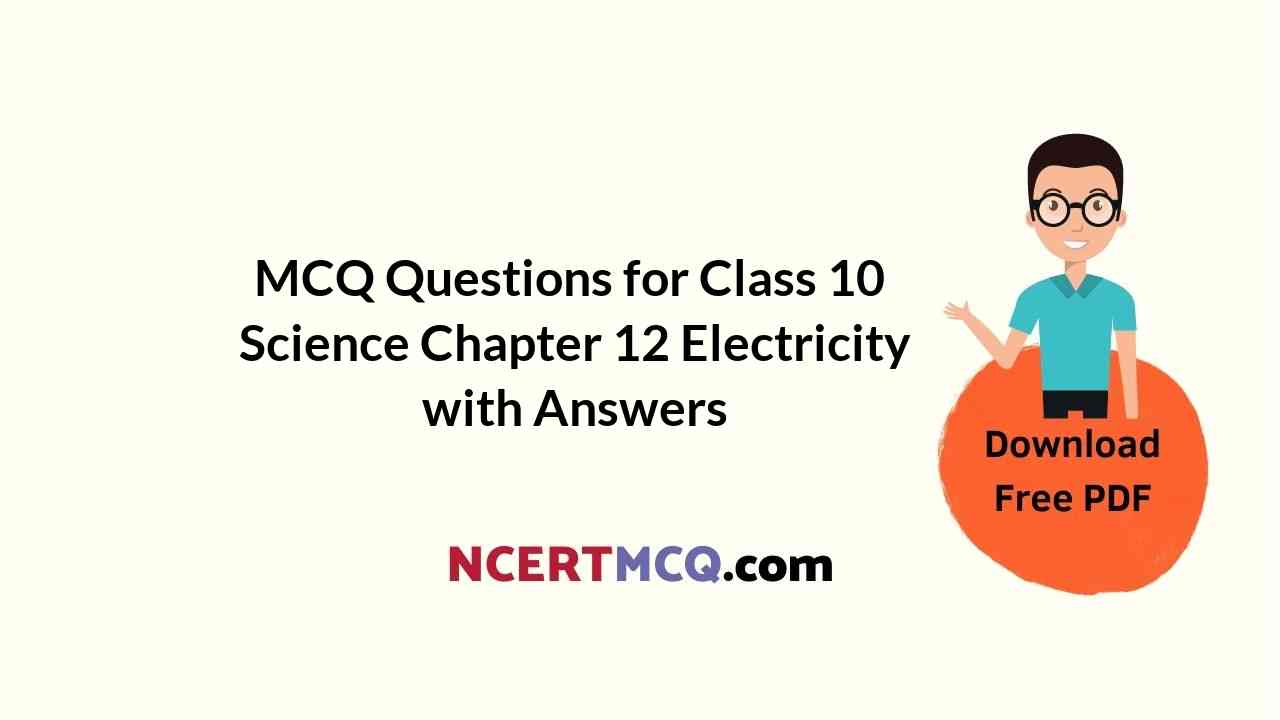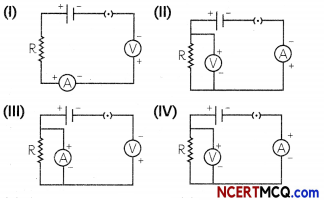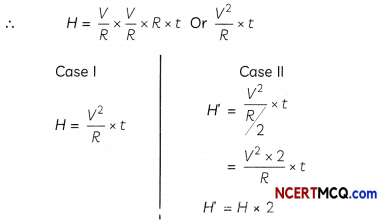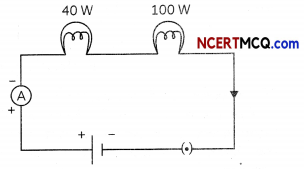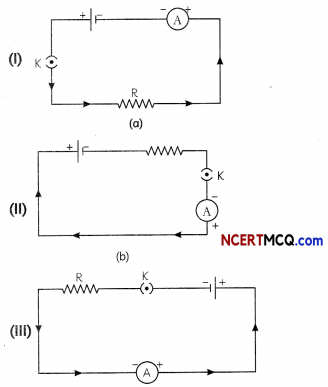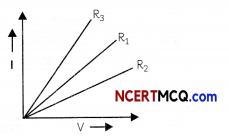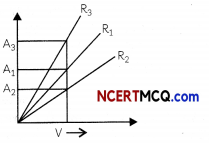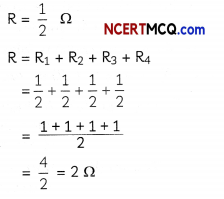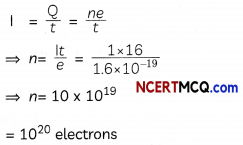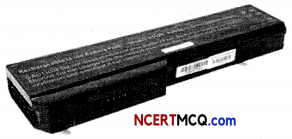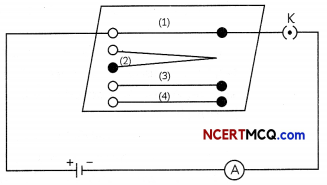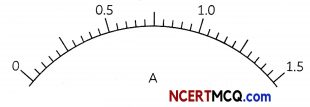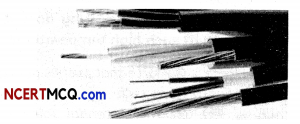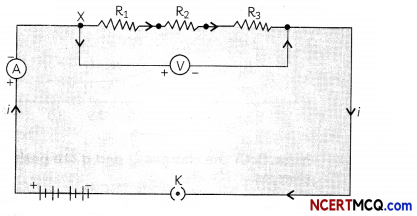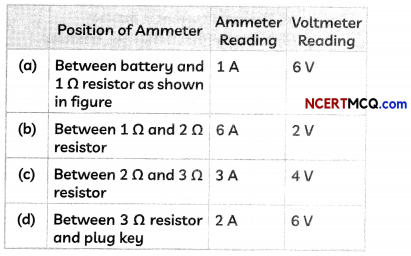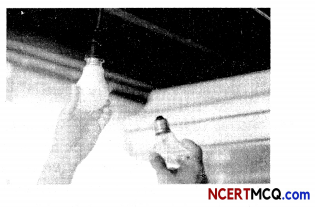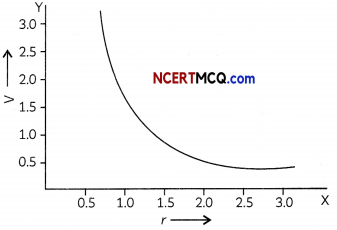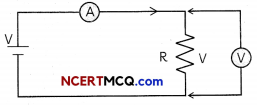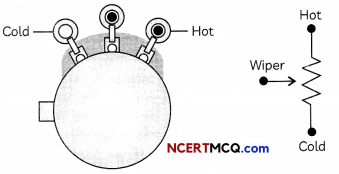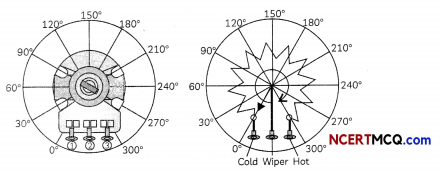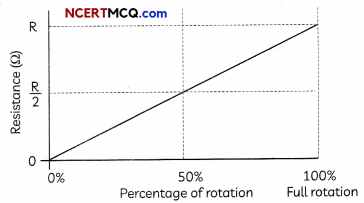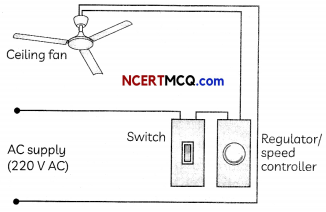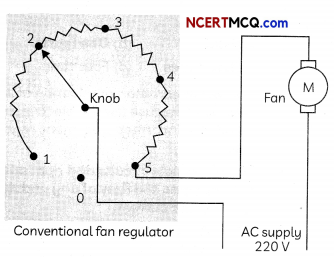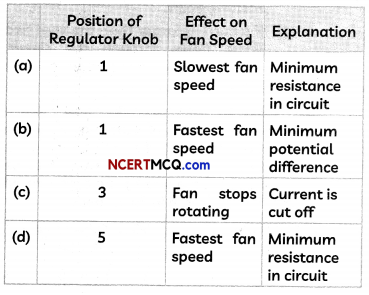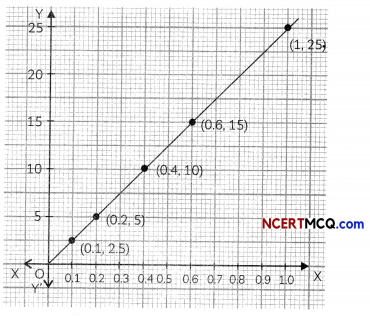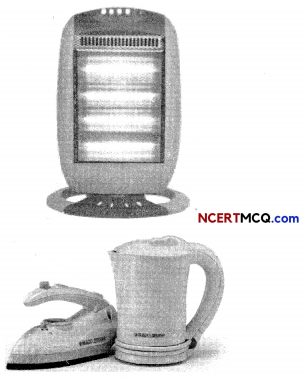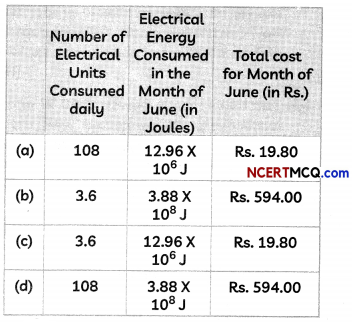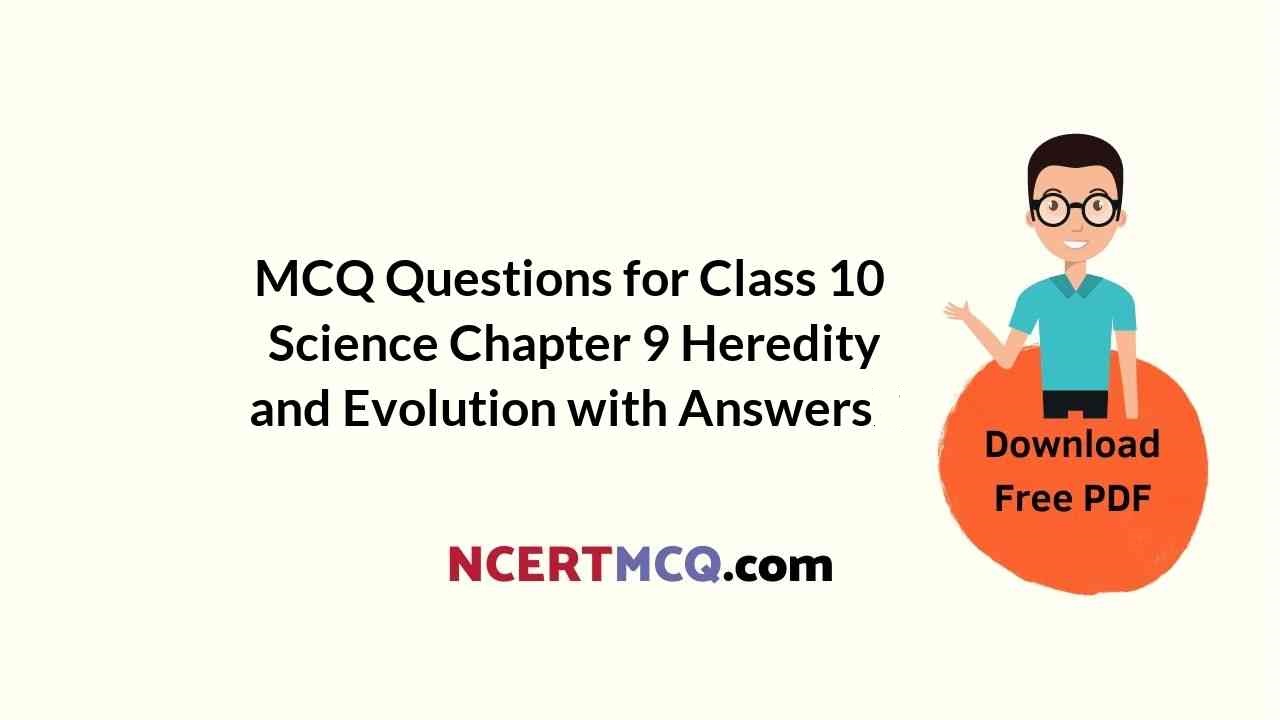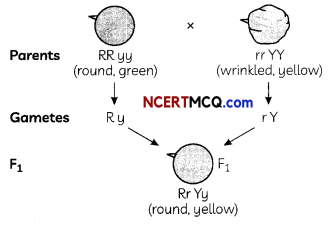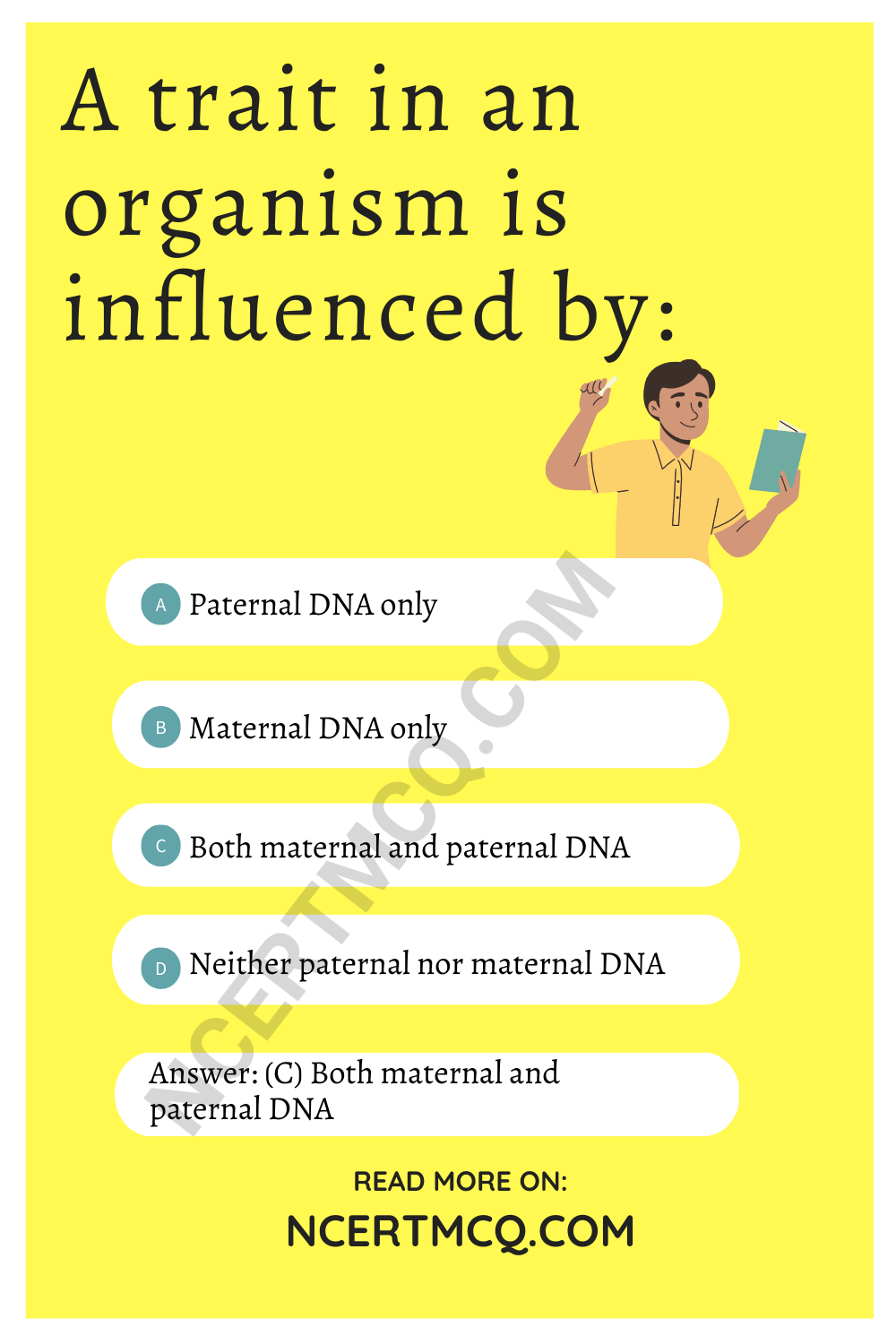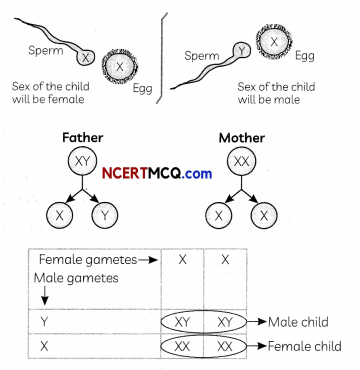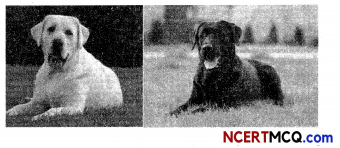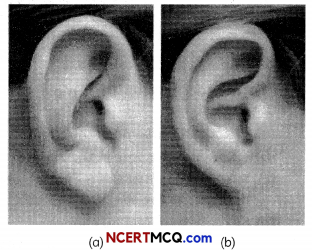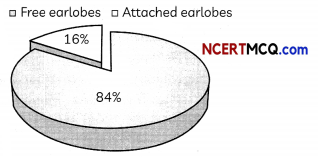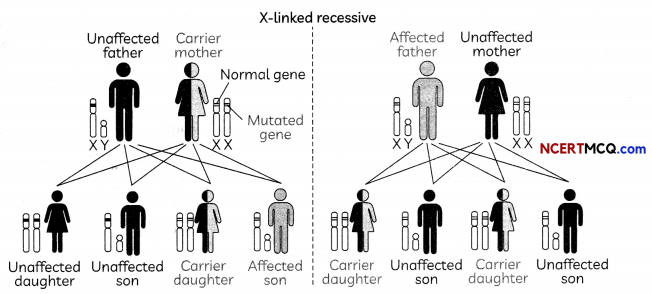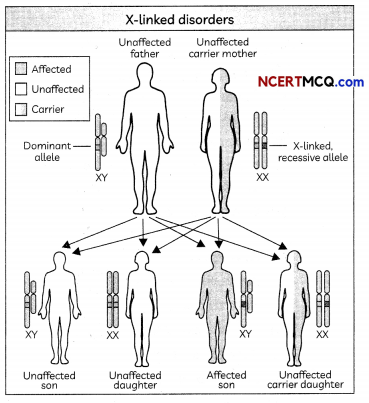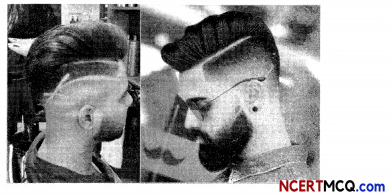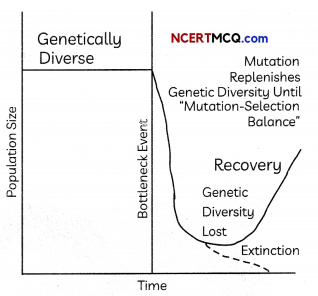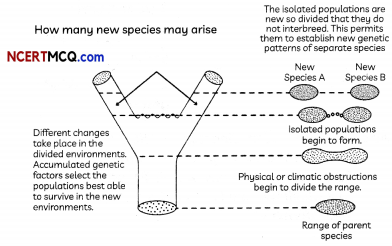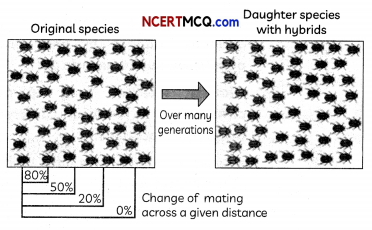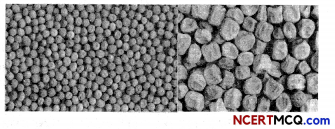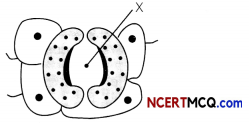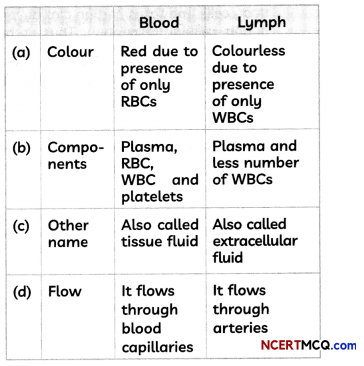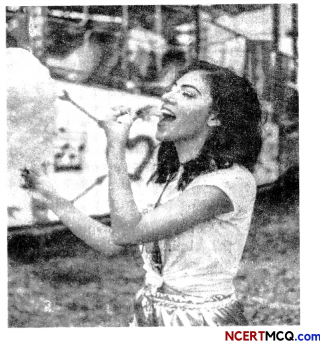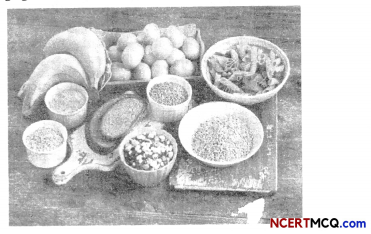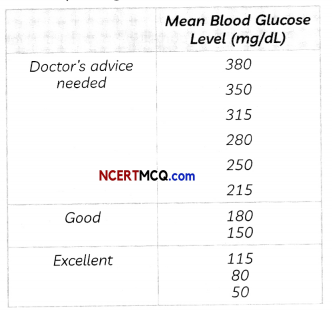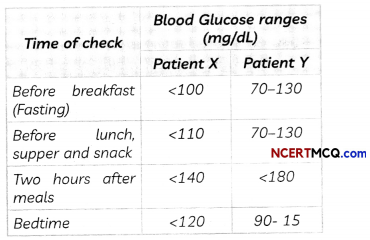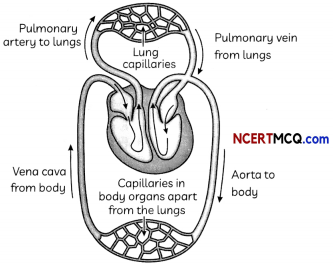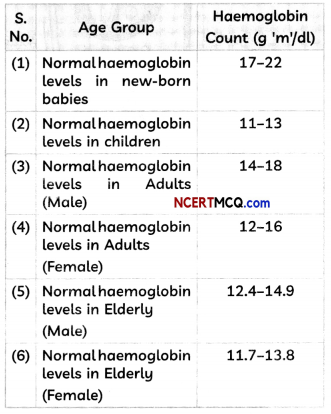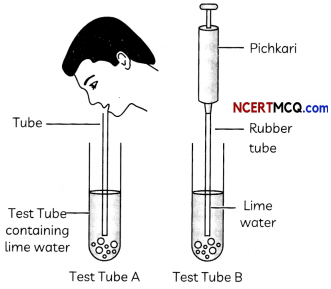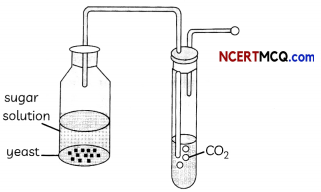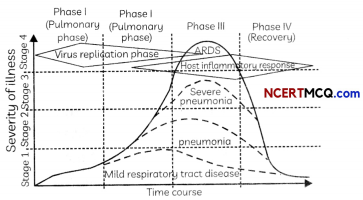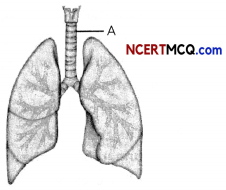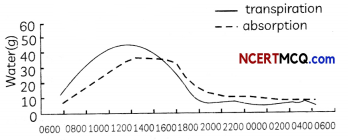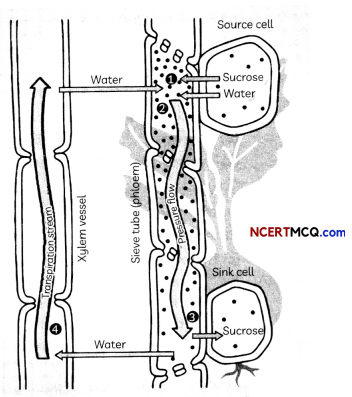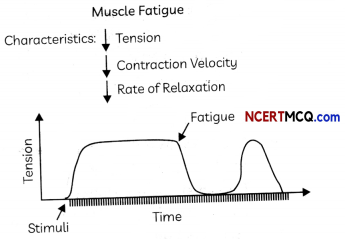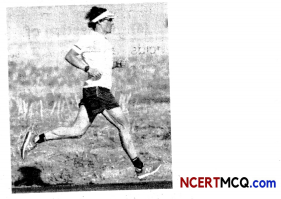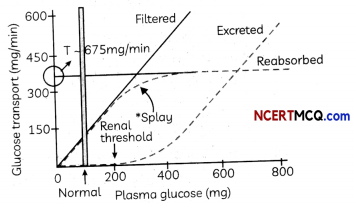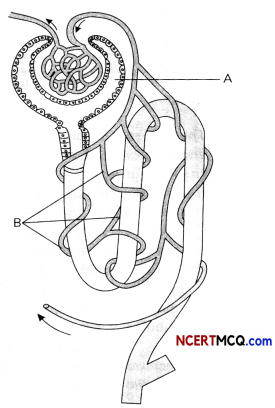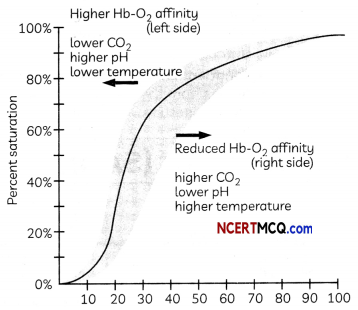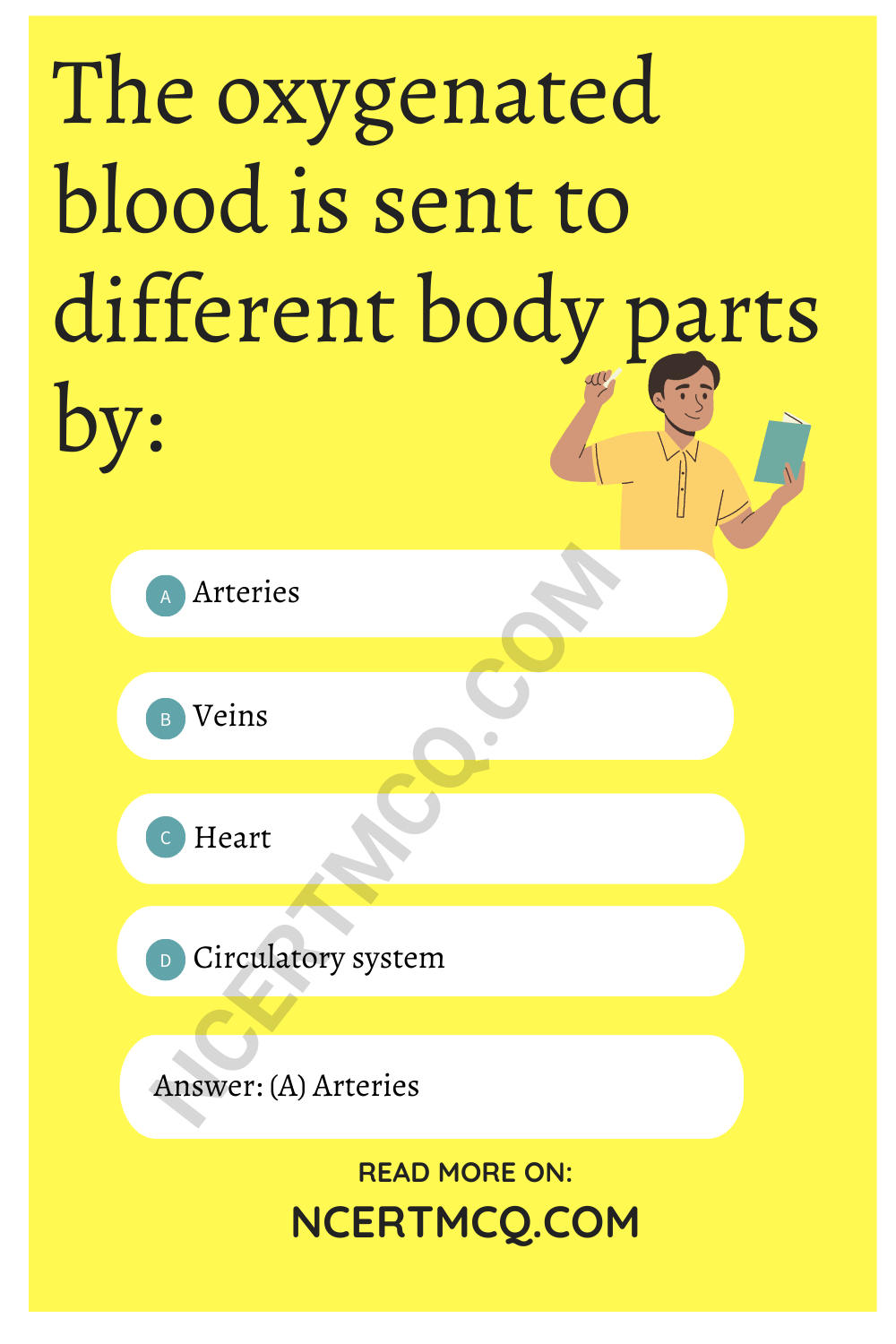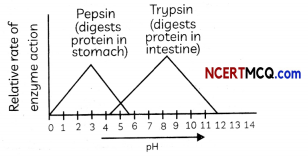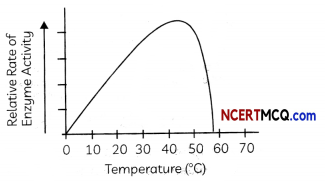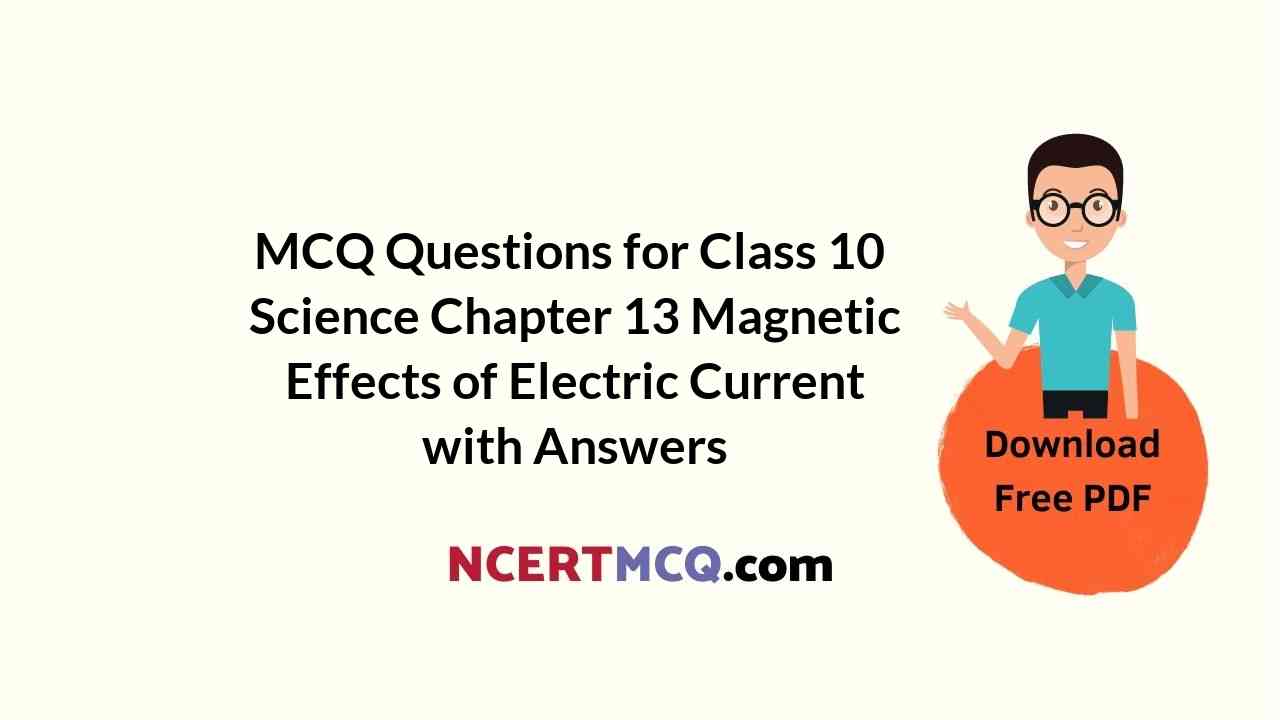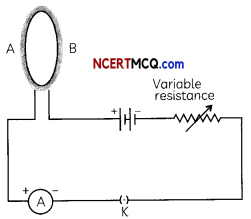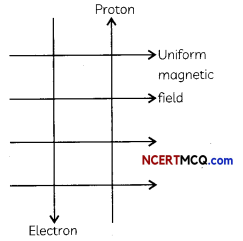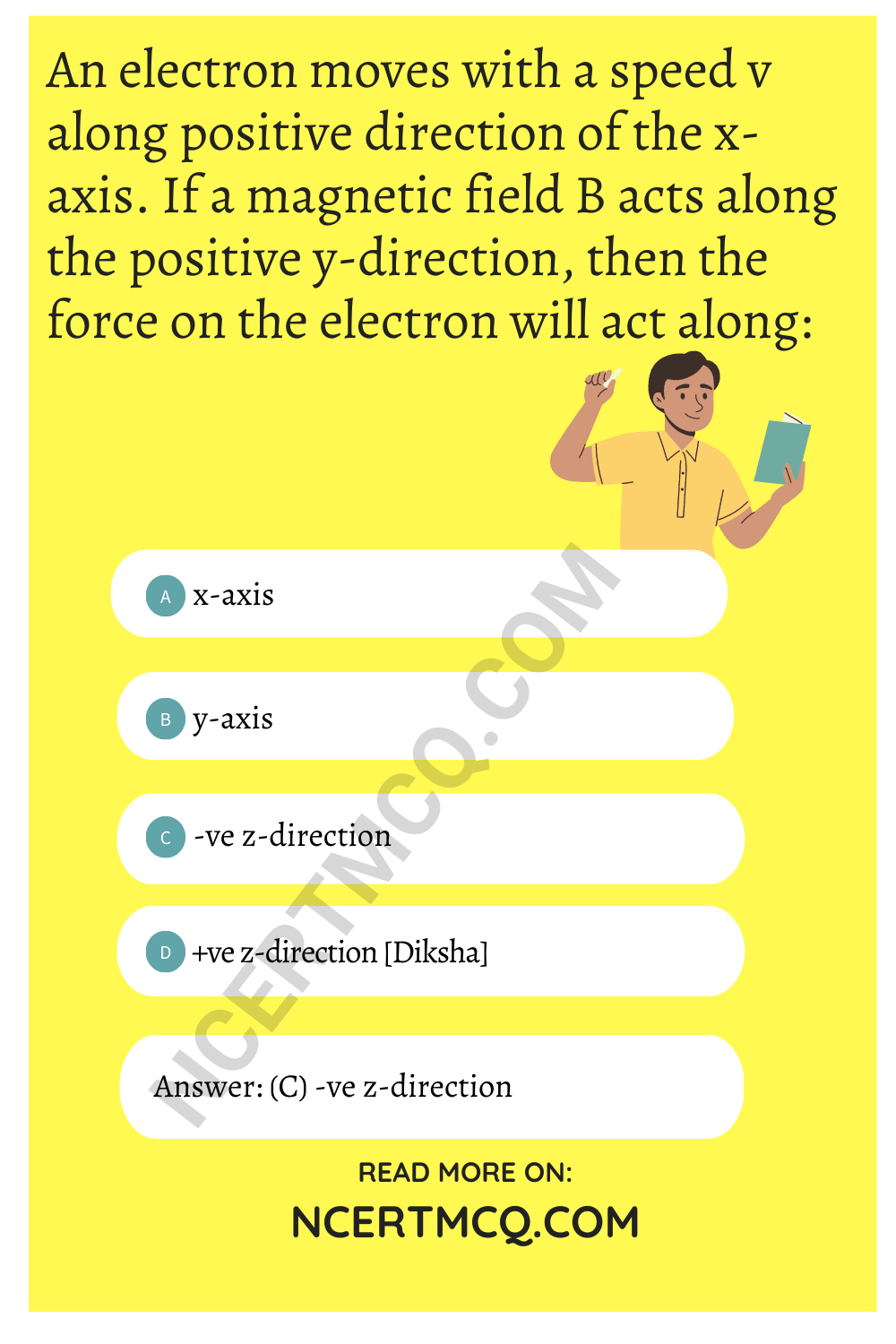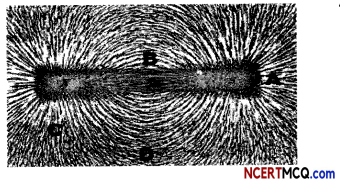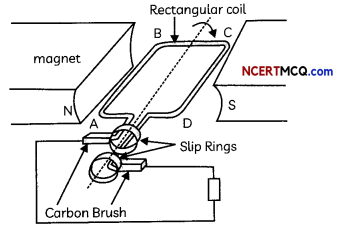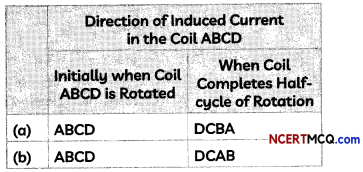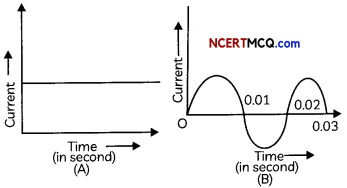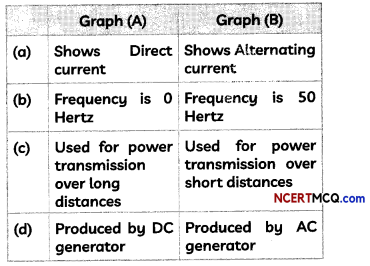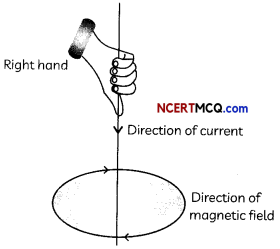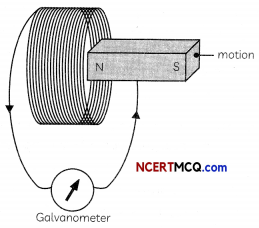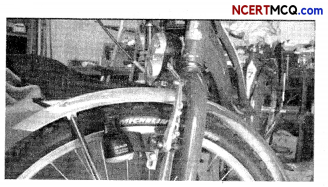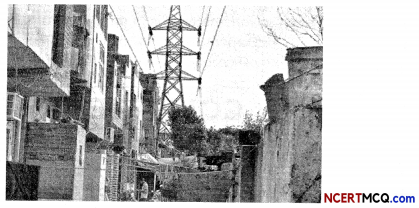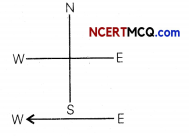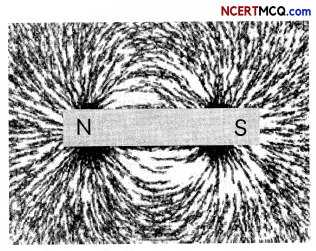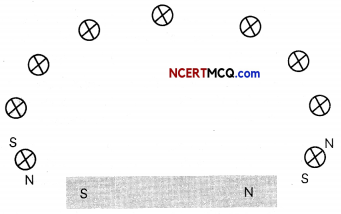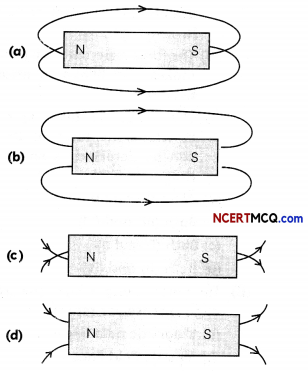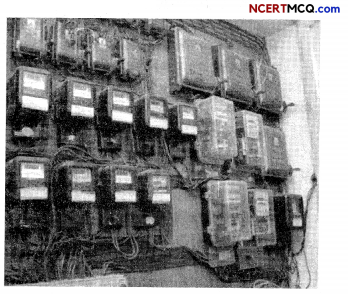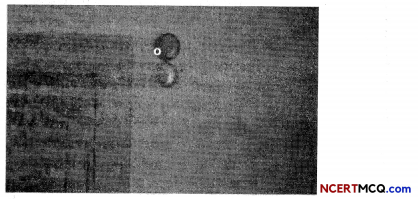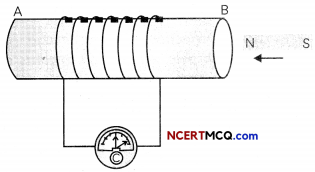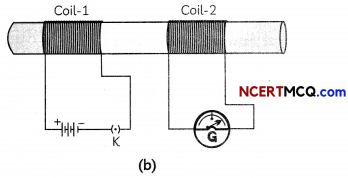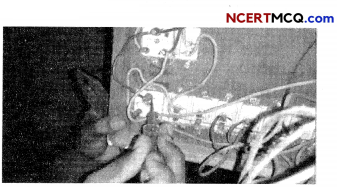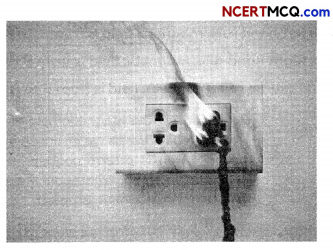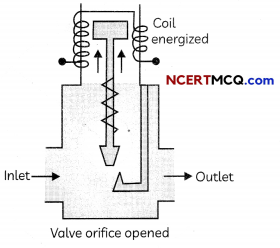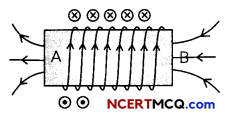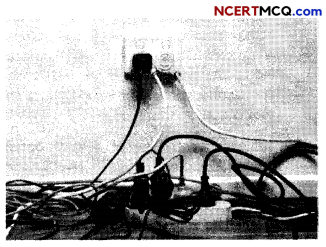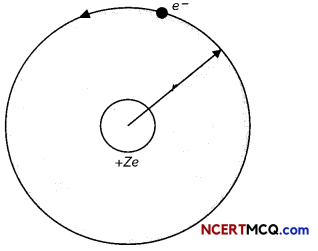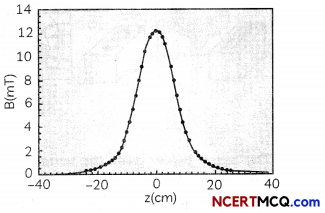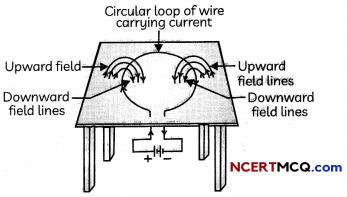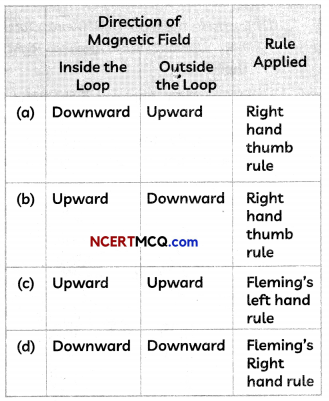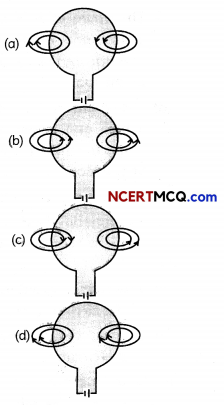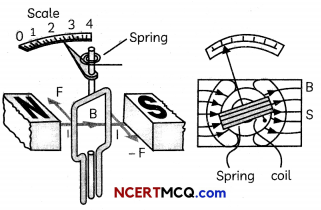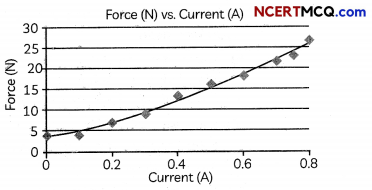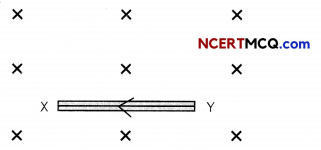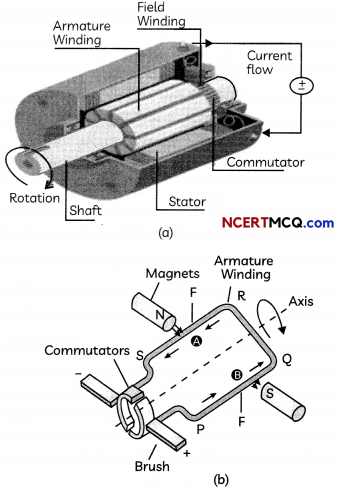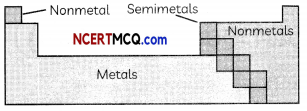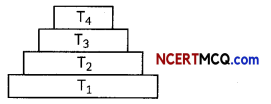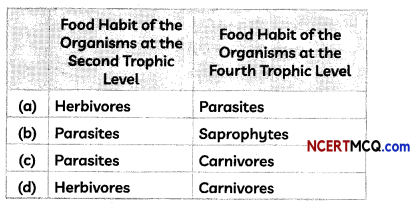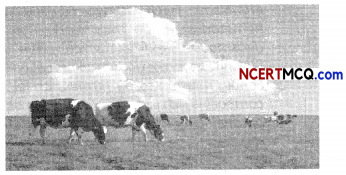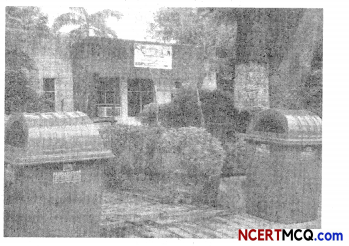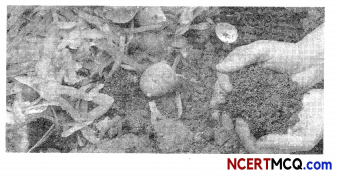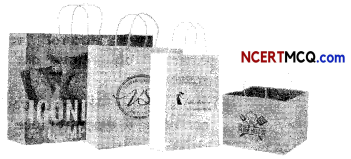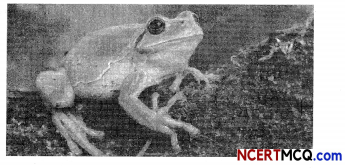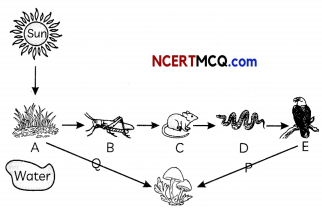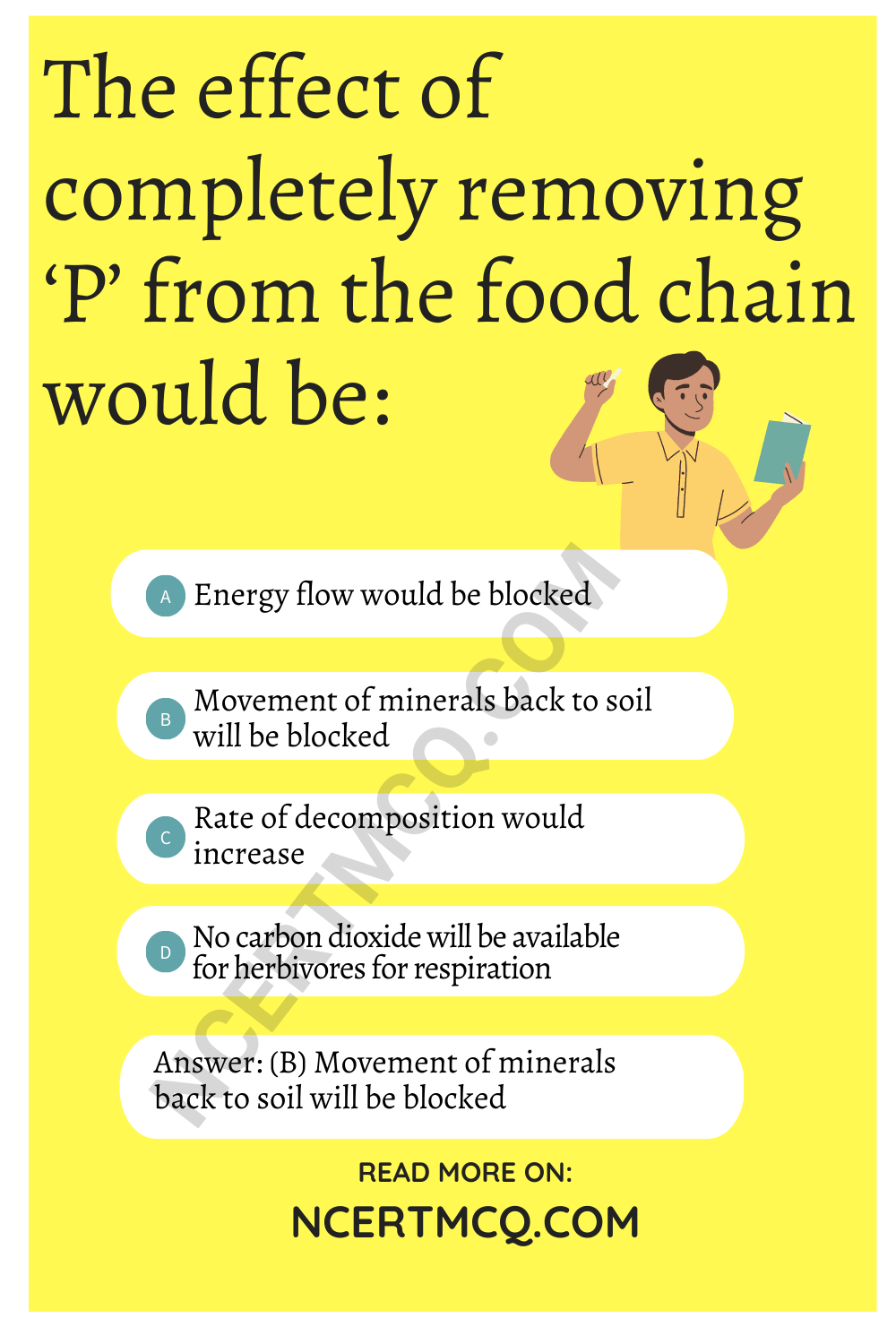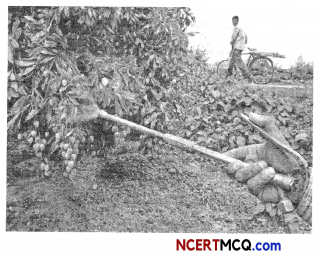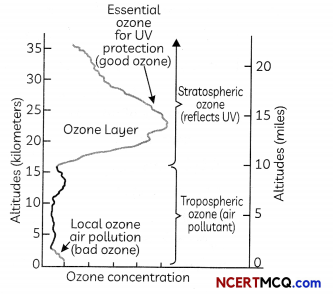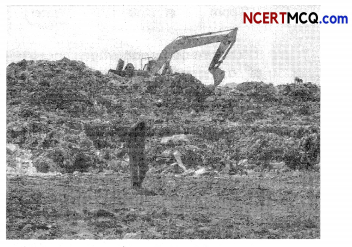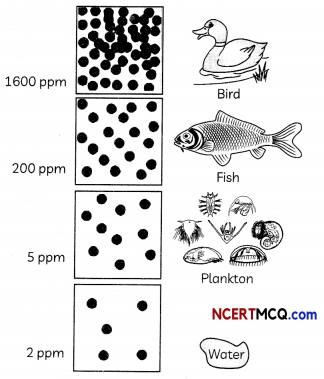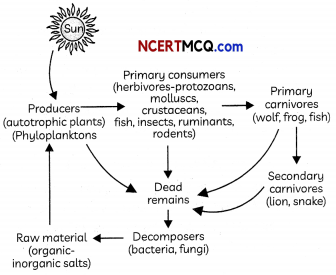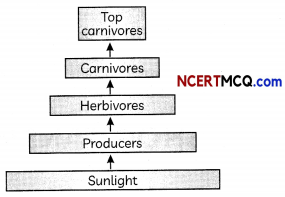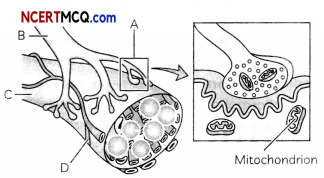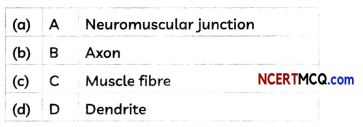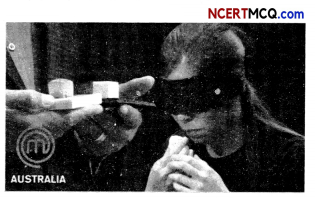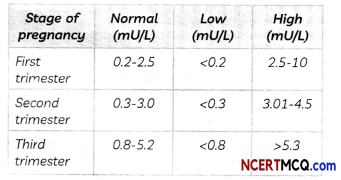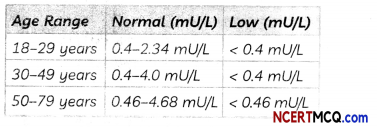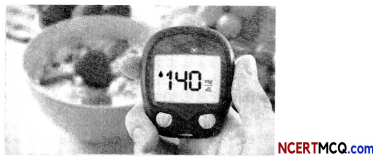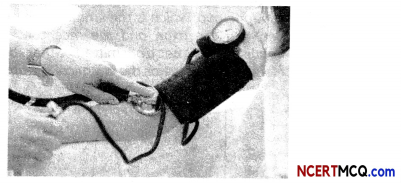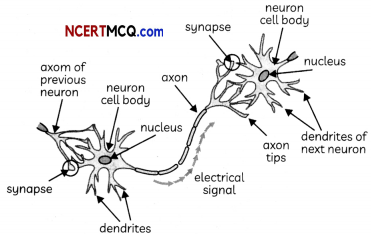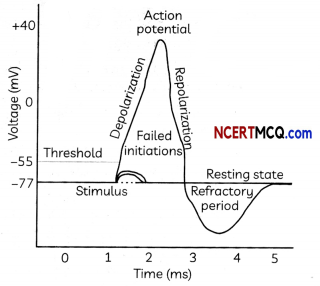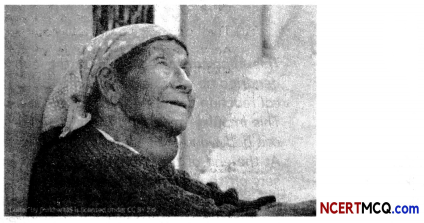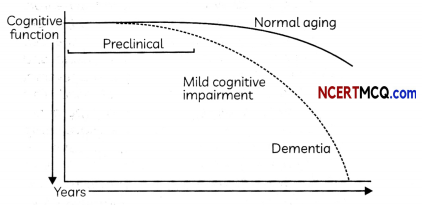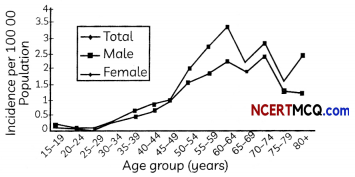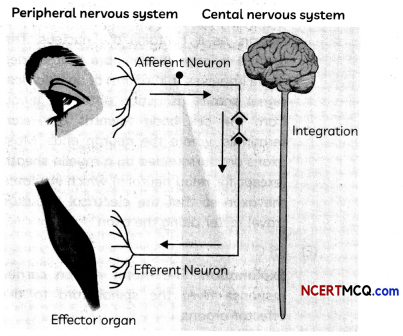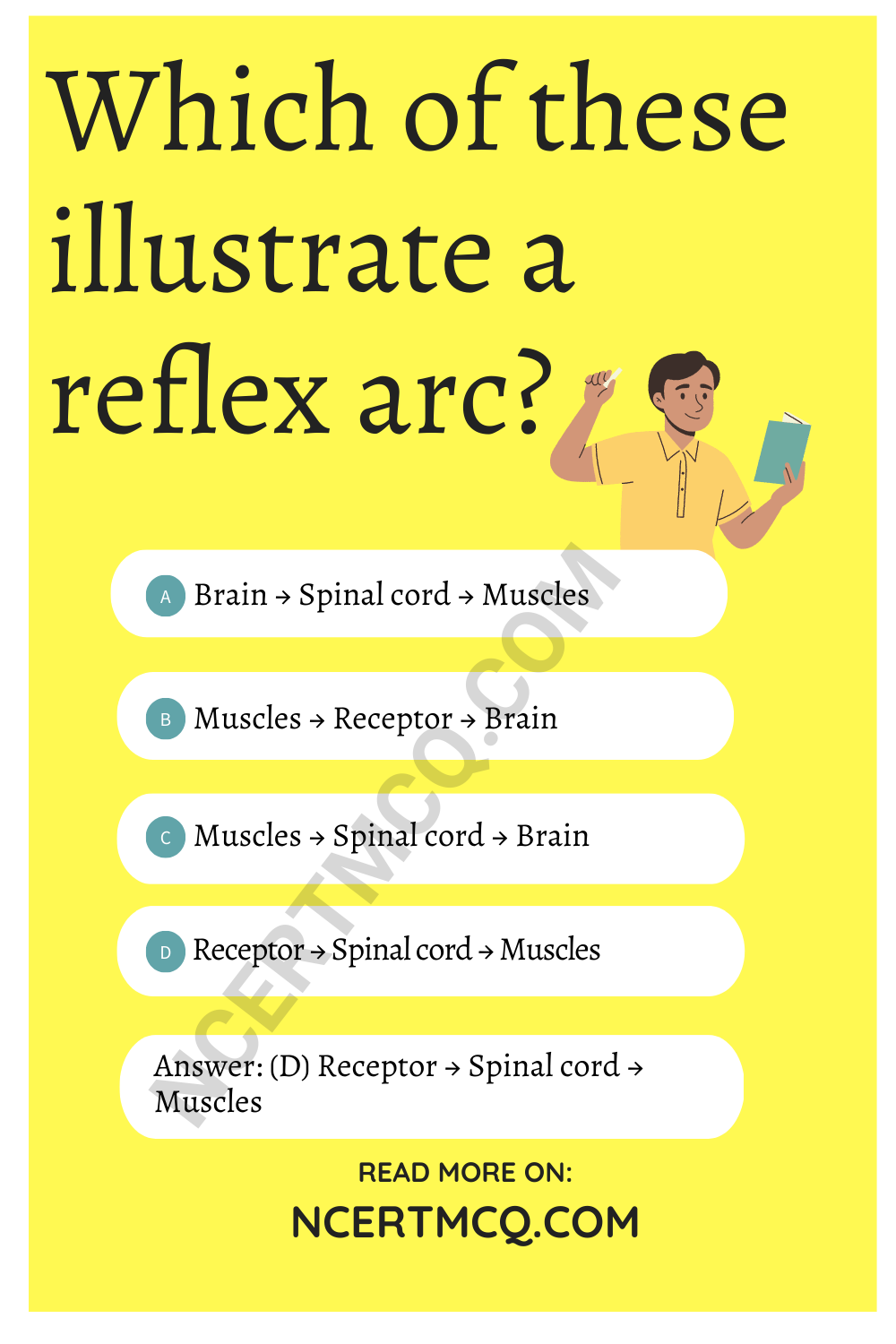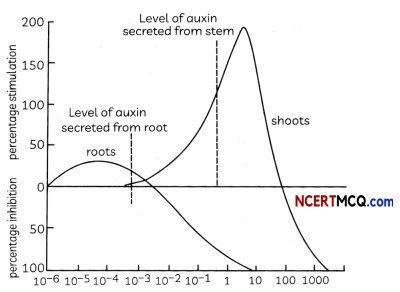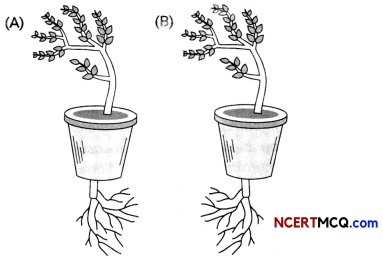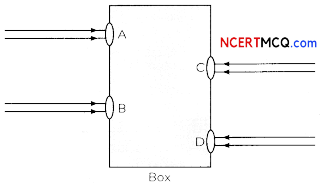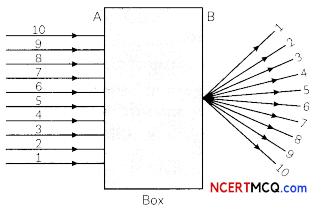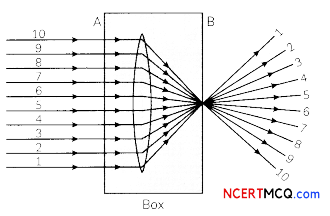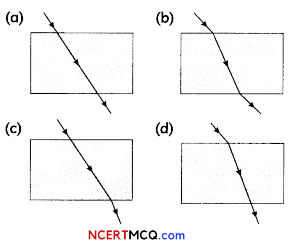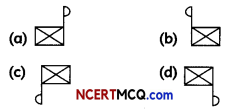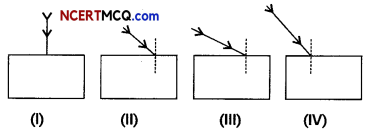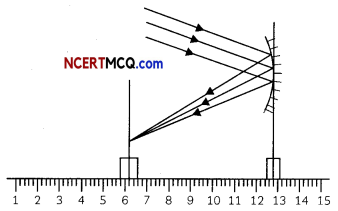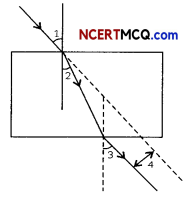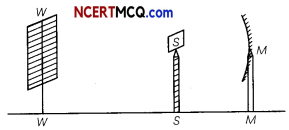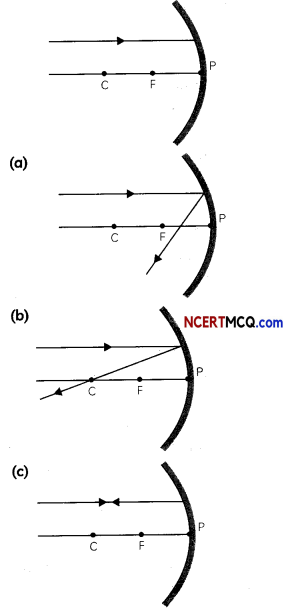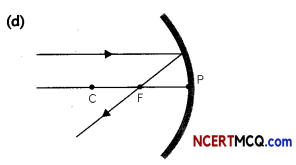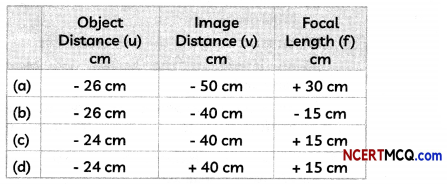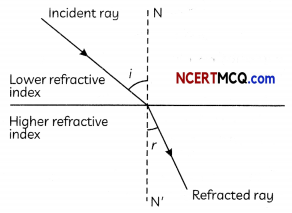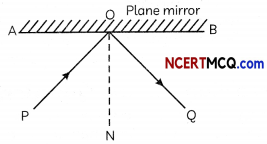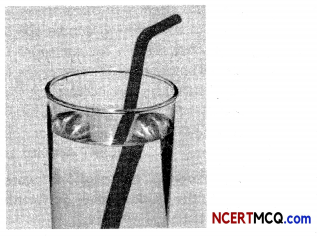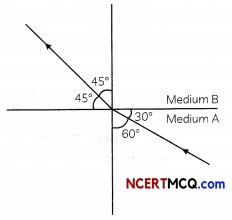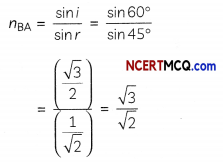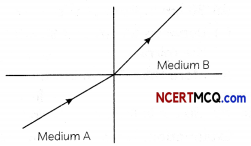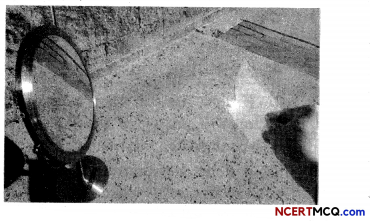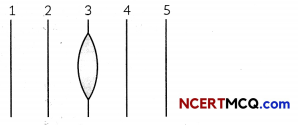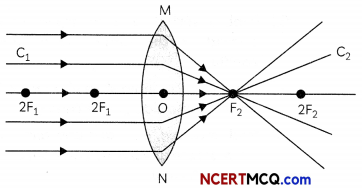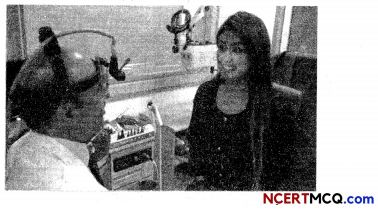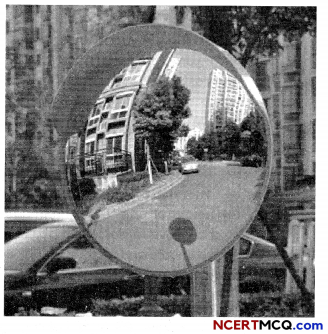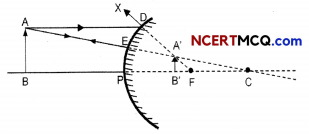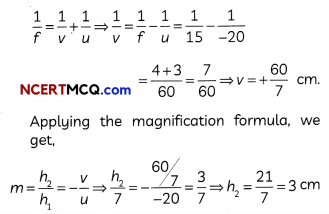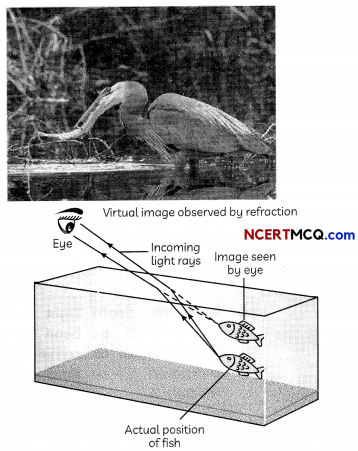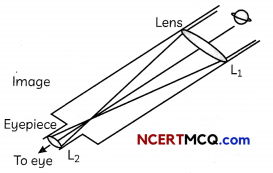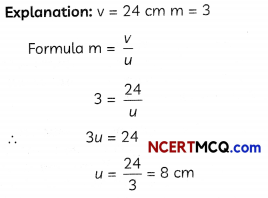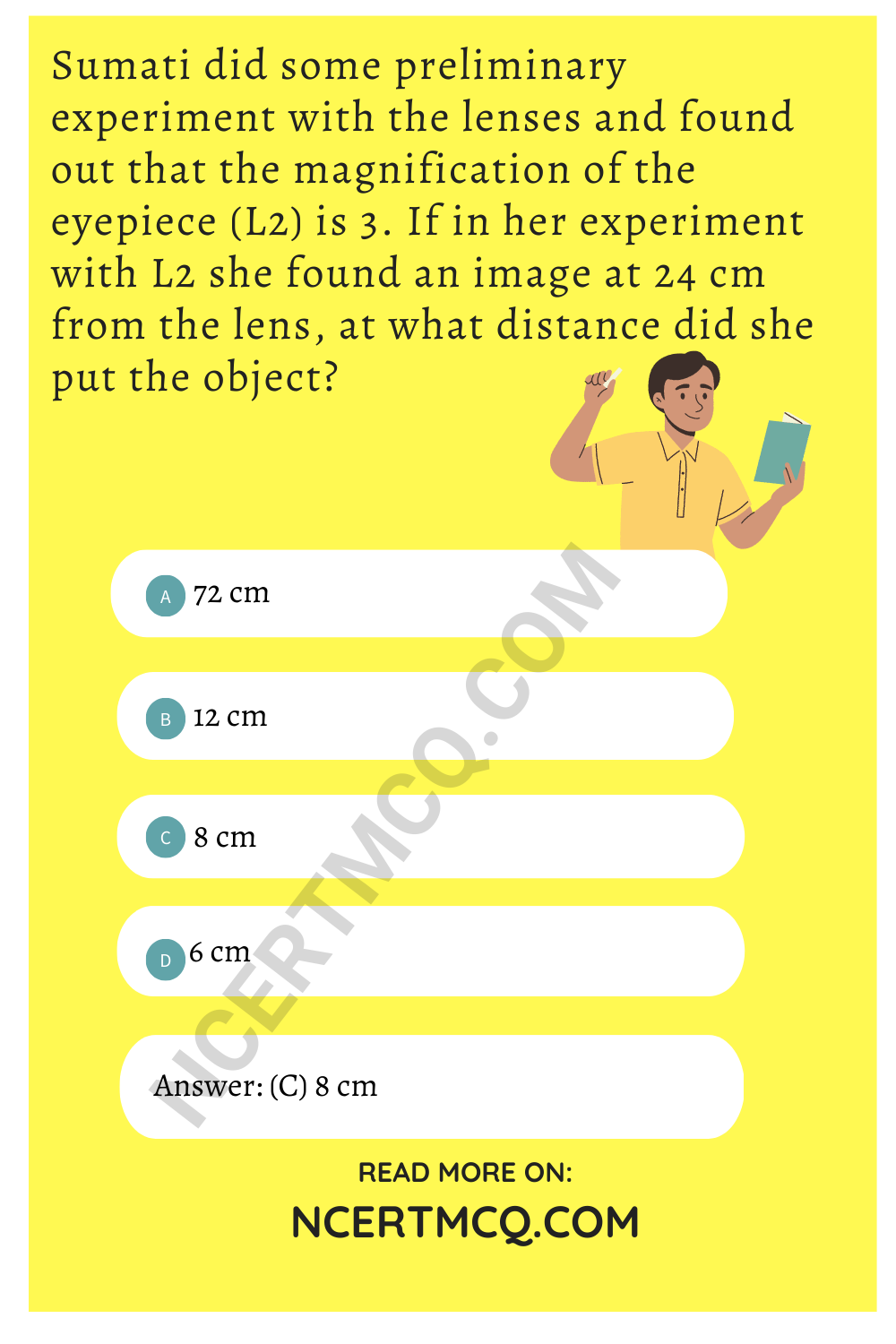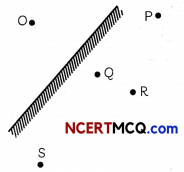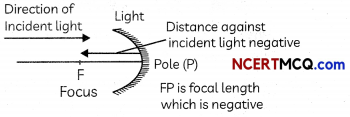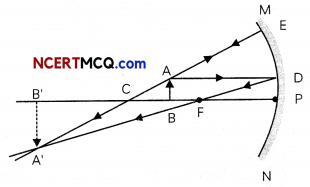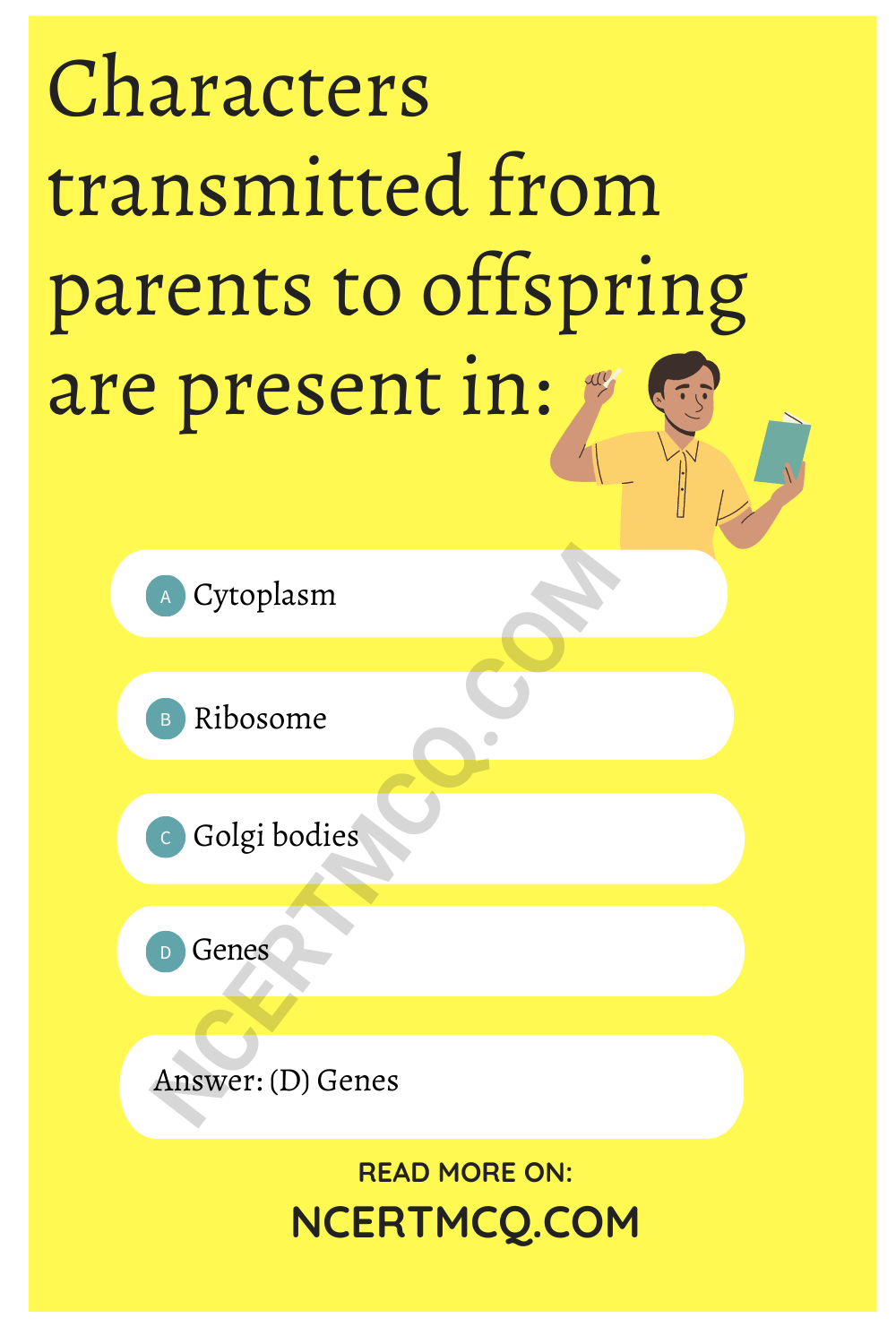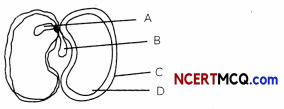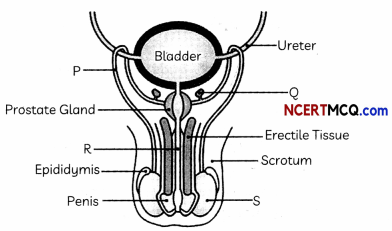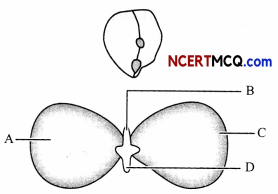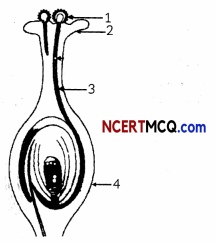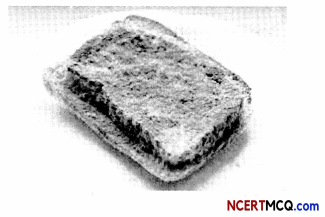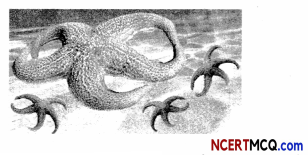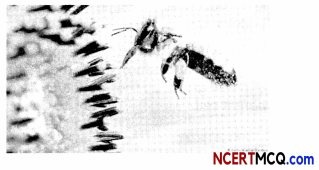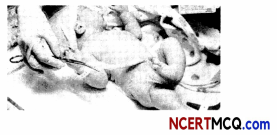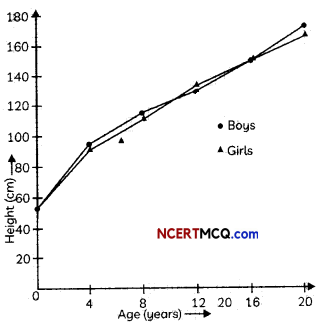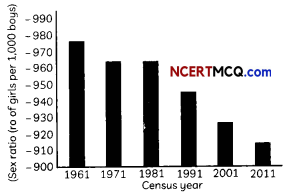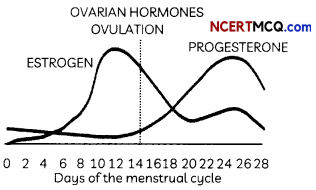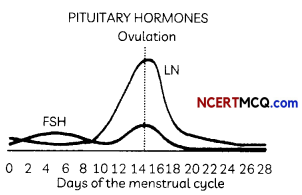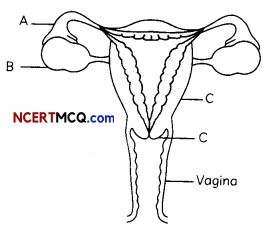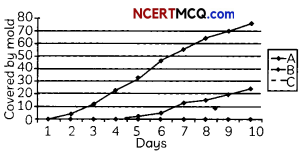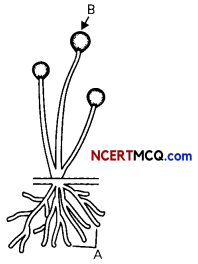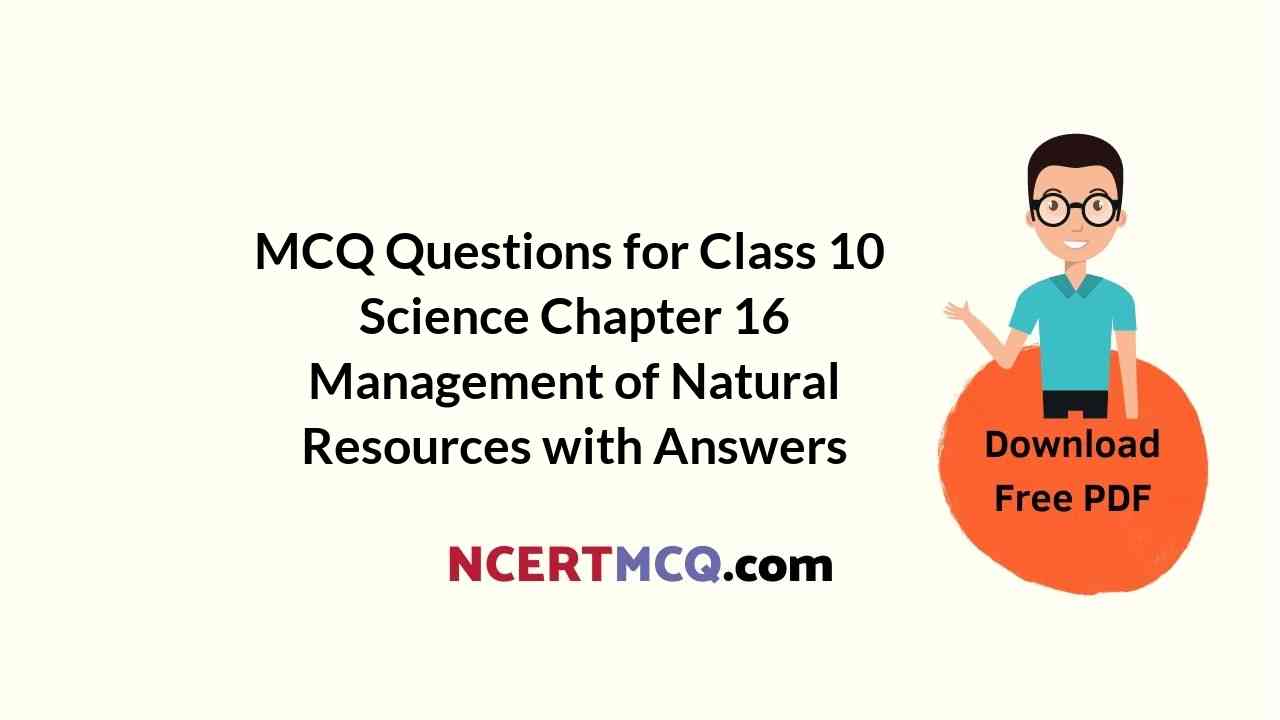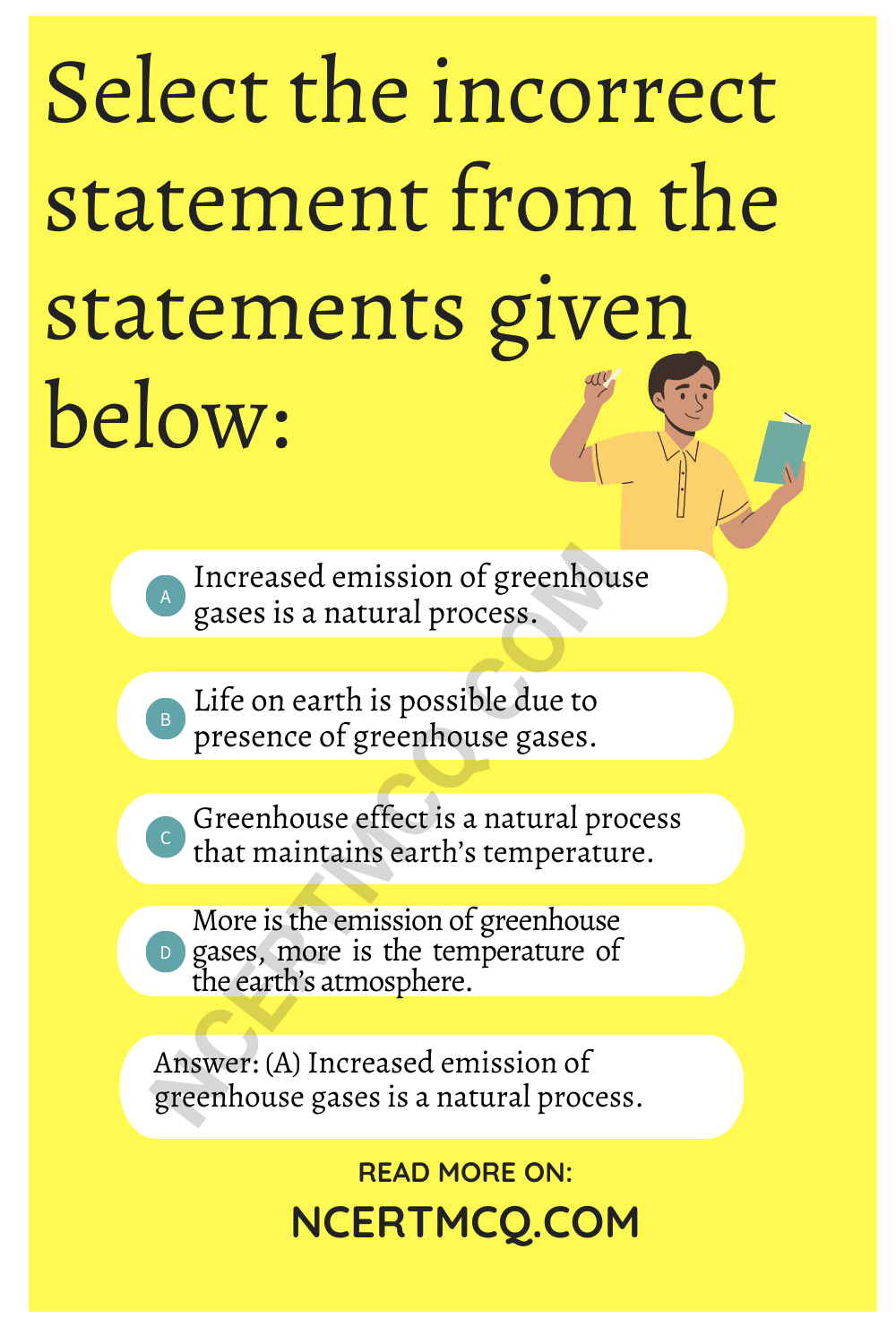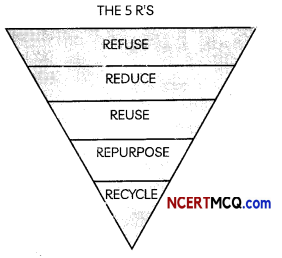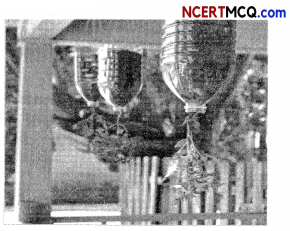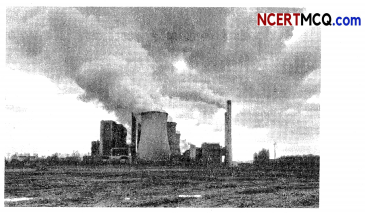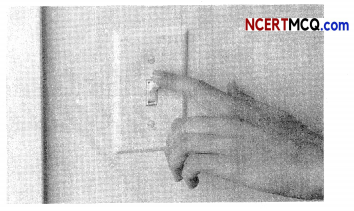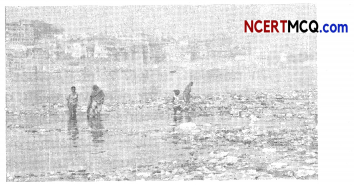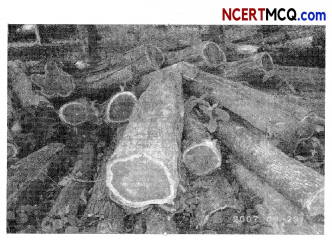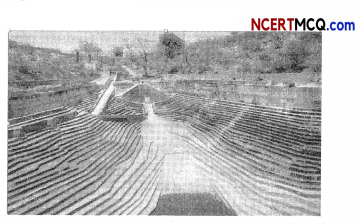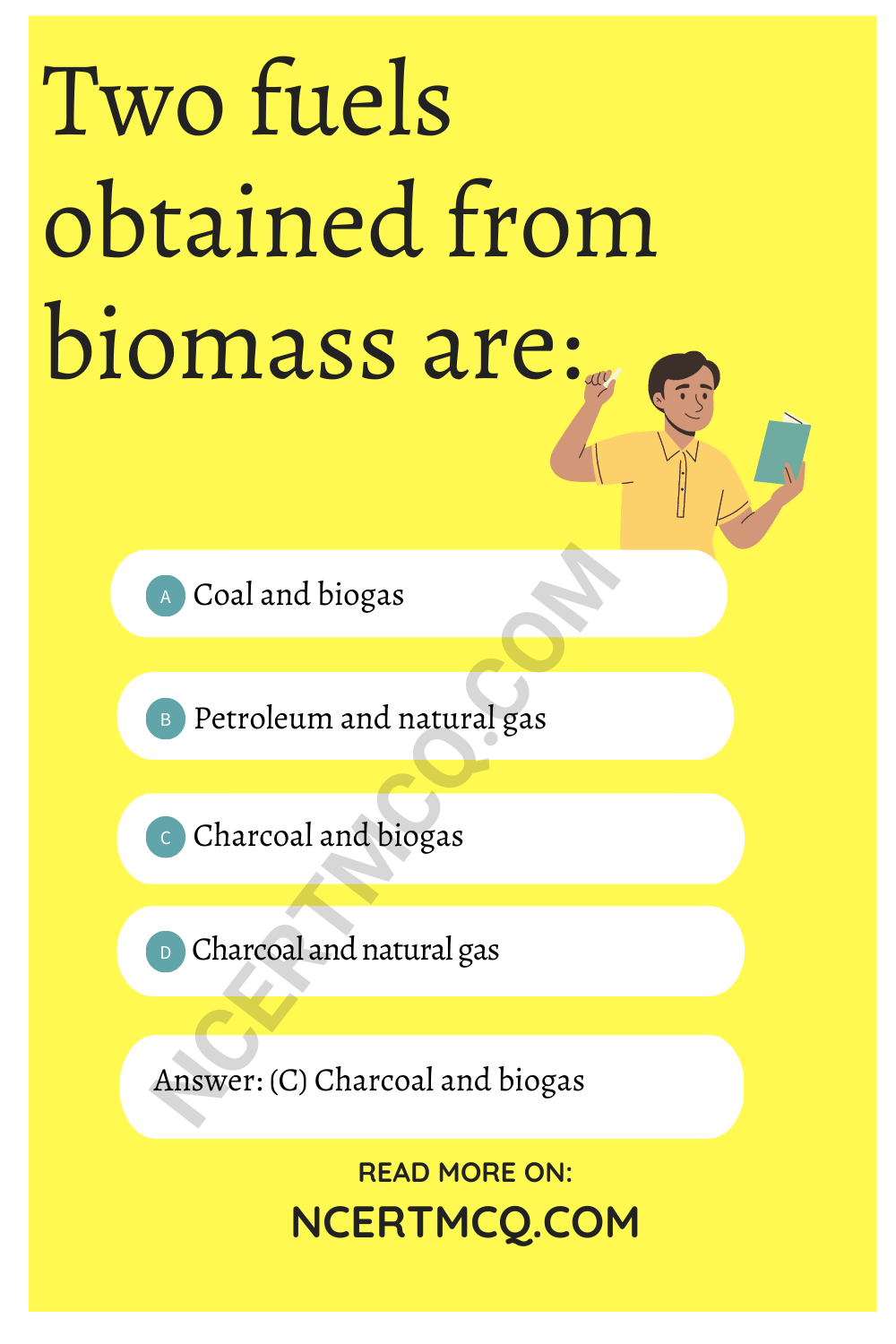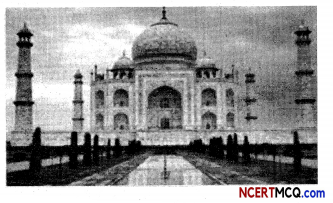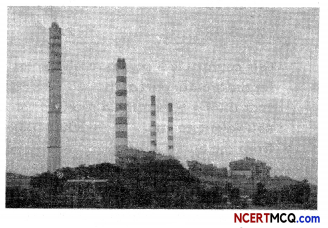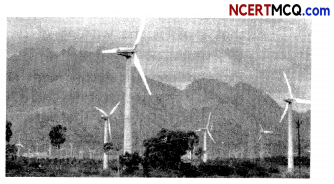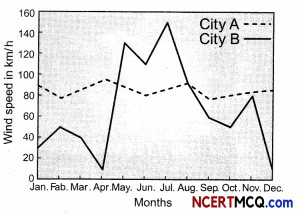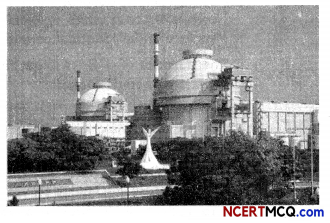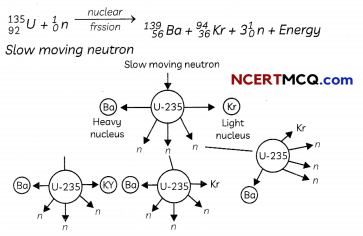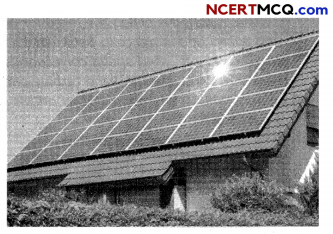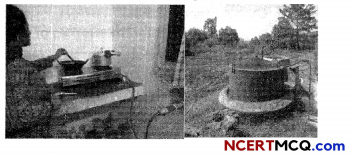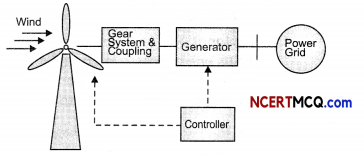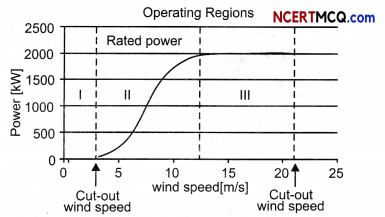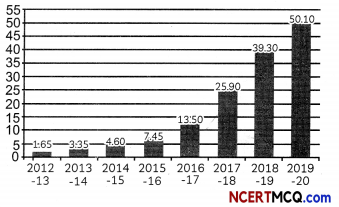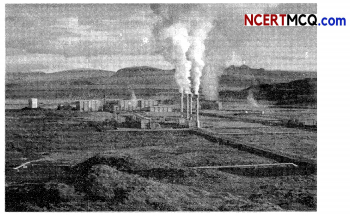Check the below Online Education NCERT MCQ Questions for MCQ Questions for Class 10 Science Chapter 11 Human Eye and Colourful World with Answers with Answers Pdf free download. https://ncertmcq.com/mcq-questions-for-class-10-science-with-answers/
Class 10 Science Physics Chapter 11 MCQ With Answers
Physics Class 10 Chapter 11 MCQs On Human Eye and Colourful World
Human Eye And Colourful World Class 10 MCQ Question 1.
A student traces the path of a ray of light through a glass prism for different angles of incidence. He analyses each diagram and draws the following conclusion:
(I) On entering prism, the Lightray bends towards its base.
(II) light ray suffers refraction at the point of incidence and point of emergence while passing through the prism.
(III) Emergent ray bends at a certain angle to the direction of the incident ray.
(IV) White emerging from the prism, the Lightray bends towards the vertex of the prism.
Out of the above inferences, the correct ones are:
(a) (I), (II) and (III)
(b) (I), (III) and (IV)
(c) (II), (III) and (IV)
(d) (I) and (IV)
Answer:
(a) (I), (II) and (III)
Related Theory:
In a prism, the ray of light from air into glass bends towards the normal. The ray of light from glass to air bends away from the normal. In both cases, when a ray of light passes through a prism, it bends towards the base of the prism.
Human Eye And Colourful World MCQ Question 2.
A clear sky appears blue, because:
(a) blue light gets absorbed in the atmosphere
(b) ultraviolet radiations are absorbed in the atmosphere
(c) violet and blue lights get scattered more than the lights of all other colours by the atmosphere
(d) lights of all other colours are scattered more than the violet and blue colour lights by the atmosphere
Answer:
Human Eye Class 10 MCQ Question 3.
Which of the following statements is correct regarding the propagation of light of different colours of white light in the air?
(a) Red light moves the fastest.
(b) Blue light moves faster than green light.
(c) All the colours of the white light travel at the same speed.
(d) Yellow light moves with the mean speed as that of red and violet light.
Answer:
![]()
Human Eye MCQ Class 10 Question 4.
In the following diagram, the correctly marked angles are:

(a) All
(b) Only ∠i, and ∠A
(c) ∠i, ∠r and ∠A
(d) ∠i, ∠A and ∠D
Answer:
Human Eye And The Colourful World MCQ Question 5.
The bluish colour of water in the deep sea is due to:
(a) the presence of algae and other plants found in water
(b) reflection of the sky in the water
(c) scattering of light
(d) absorption of light by the sea
Answer:
(c) scattering of light
Explanation: The bluish colour of water in the deep sea is due to scattering of light. The fine particles in water scatter mainly blue light having the shortest wavelength.
Related Theory:
Water appears blue because when white light from the Sun falls on the water molecules, only blue light is reflected and scattered and reaches our eyes.
The absorption of light by a molecule depends on the wavelength and the size of the molecule. A molecule absorbs light of a wavelength either equal to or greater than the order of the size of the object.
Since red, orange and yellow have longer wavelengths, they are absorbed by the water molecules, whereas blue, having a shorter wavelength, is scattered.
Colourful World Class 10 MCQ Question 6.
During the experiment, to trace the path of ray of light through the glass prism, students reported the following observations:
(I) The ray of light from air to glass at the first refracting surface bends away from the normal after refraction.
(II) At the second refracting surface, light rays entered from air to glass.
(III) Lightray suffers two refractions on passing through a prism and in each refraction it bends towards the base of the prism.
(IV) Lightray suffers two refractions on passing through a prism. In first refraction, it bends away from the normal while in the second refraction it bends towards the normaL
The correct observation is/are:
(a) (I) and (II) only
(b) (III) only
(c) (II) and (IV) only
(d) (I) and (IV) only
Answer:
![]()
Class 10 Human Eye And The Colourful World MCQ Question 7.
In an experiment to trace the path of a ray of light through a triangular glass prism, a student would observe that the emergent ray
(a) is parallel to the incident ray.
(b) is along the same direction of incident ray.
(c) gets deviated and bends towards the thinner part of the prism.
(d) gets deviated and bends towards the thicker part (base) of the prism.
Answer:
Class 10 Science Chapter 11 MCQ Question 8.
In the following ray diagram the correctly marked angle are:

(a) ∠i, and ∠e
(b) ∠A and ∠D
(c) ∠i, ∠e and ∠D
(d) ∠r, ∠A and ∠D
Answer:
(d) ∠r, ∠A and ∠D
Human Eye And Colourful World Class 10 MCQ With Answers Question 9.
A person cannot see distinctly the objects kept beyond 2 m. This defect can be corrected by using a lens of power:
(a) + 0.5 D
(b) – 0.5 D
(c) + 0.2 D
(d) – 0.2 D
Answer:
MCQ Of Human Eye Class 10 Question 10.
A student sitting on the last bench can read the letters written on the blackboard but is not able to read the letters written in his textbook. Which of the following statements is correct?
(a) The near point of his eyes has receded away.
(b) The near point of his eyes has come closer to him.
(c) The far point of his eyes has come closer to him.
(d) The far point of his eyes has receded away.
Answer:
(a) The near point of his eyes has receded away.
Explanation: The student can see the object which is far from him but can’t see nearby objects. It means that the near point of his eyes has receded away. This condition is known as hypermetropia or farsightedness.
MCQ On Human Eye Class 10 Question 11.
When light rays enter the eye, most of the refraction occurs at the:
(a) crystalline lens
(b) the outer surface of the cornea
(c) iris
(d) pupil
Answer:
(b) the outer surface of the cornea
Explanation: Light enters the eye through a thin membrane called the cornea. It causes most of the bending of incident light rays, i.e. refraction, to make them converge which in turn causes image formation on the retina.
![]()
Ch 11 Science Class 10 MCQ Question 12.
The focal length of the eye lens increases when eye muscles:
(a) are relaxed and the lens becomes thinner
(b) contract and the lens becomes thicker
(c) are relaxed and the lens becomes thicker
(d) contract and the lens becomes thinner
Answer:
The Colourful World Class 10 MCQ Question 13.
Which of the following statements is correct?
(a) A person with myopia can see distant objects clearly.
(b) A person with hypermetropia can see nearby objects clearly.
(c) A person with myopia can see nearby objects clearly.
(d) A person with hypermetropia cannot see distant objects clearly.
Answer:
(c) A person with myopia can see nearby objects clearly.
Explanation: Myopia is also termed as short-sightedness. A person suffering from myopia can see nearby objects clearly but not the distant objects. Whereas hypermetropia is termed as long-sightedness. A person suffering from hypermetropia can see distant objects clearly but not the nearby objects.
Class 10 Science Ch 11 MCQ Question 14.
Person suffering from cataract has:
(a) elongated eyeball
(b) excessive curvature of eye lens
(c) weakened ciliary muscles
(d) opaque eye Lens
Answer:
Human Eye And The Colourful World Class 10 MCQ Question 15.
When we enter a dark room coming from outside, immediately the things inside the room do not appear clear to our eyes. This is because:
(a) pupils do not open at all in the dark.
(b) pupils take time to adjust.
(c) light travels slower in a dark room.
(d) pupils open very quickly in the dark.
Answer:
MCQ Of Colourful World Class 10 Question 16.
The phenomena of light responsible for the working of the human eye is:
(a) reflection
(b) refraction
(c) power of accommodation
(d) persistence of vision
Answer:
![]()
MCQs On Human Eye And Colourful World Question 17.
The sky appears dark to passengers flying at very high altitudes mainly because:
(a) Scattering of light is not enough at such heights.
(b) There is no atmosphere at great heights.
(c) The size of molecules is smaller than the wavelength of visible light.
(d) The light gets scattered towards the earth.
Answer:
(a) Scattering of light is not enough at such heights.
Explanation: At higher altitude either the atmospheric medium is very rare or there are no particles present/ no atmosphere, thus the scattering of light taking place is not enough at such heights or no scattering of sunlight takes place. Hence, the sky appears dark to the passengers flying at very high altitude.
MCQ Of Human Eye And Colourful World Question 18.
Given below are some common observations related to optics. Select the row containing incorrect observations and its reason.
| Observation | Reason |
| (a) Colour of water in deep sea | Scattering of light |
| (b) Apparent position of stars | Atmospheric refraction |
| (c) Fishes appear higher than their actual depth | Diffraction of light |
| (d) Spectrum seen on soap bubbles | Dispersion of light |
Answer:
(c) Observation: Fishes appear higher than their actual depth, Reason: Diffraction of light
Explanation: Fishes appear higher than their actual depth due to the refraction of light as light travels from water, an optically denser medium, to air, a rarer medium. Diffraction of light refers to the phenomena of bending of light around corners.
Class 10 Physics Human Eye And The Colourful World MCQ Question 19.
The defective eye of a person has near point 0.5 m and far point 75 cm. The table below lists the type of corrective lens and its power required for reading purposes and for seeing distant objects.
Select the row containing the correct information:
| For reading purpose | For seeing distant objects |
| (a) Concave lens of power – 0.5 D | Convex lens of power + 0.75 D |
| (b) Convex lens of power +0.5 D | A concave lens of power – 0.75 D |
| (c) Convex Lens of power + 0.5 D | Concave Lens of power-1.33 D |
| (d) Convex Lens of power + 2.0 D | Concave Lens of power -1.33 D |
Answer:
![]()
MCQ Questions For Class 10 Human Eye And Colourful World Question 20.
A 55-year-old near-sighted person wears spectacles with a power of – 2.5 D for distance viewing. His doctor prescribes a correction of + 2.0 D in the near-vision section of his bifocals. This is measured relative to the main part of the lens.
Select the correct statements:
(I) The focal length of the distance-viewing part of the lens is – 40 cm.
(II) The focal length of the near-vision part of the lens is + 50 cm.
(III) The focal length of the distance-viewing part of the lens is + 50 cm.
(IV) The focal length of the near-vision part of the lens is – 40 cm.
(a) Both (I) and (II)
(b) Both (I) and (IV)
(c) Both (II) and (III)
(d) Both (III) and (IV)
Answer:
Class 10 Science Human Eye And Colourful World MCQ Question 21.
A beam of white light falling on a glass prism gets split up into seven colours marked 1 to 7 as shown in the diagram
Select the incorrect statements regarding the colours marked from 1 to 7:
(I) The colour at position marked 7 and 5 are similar to the colour of the blood and colour of gold metal respectively.
(II) The colour at position marked 1 and 3 are similar to the colour of the blood and colour of gold metal respectively.
(III) The colour at position marked 3 and 4 are similar to the colour of the sky and colour of leaves in plants respectively.
(IV) The colour at position marked 5 and 4 are similar to the colour of the sky and colour of leaves in plants respectively.
(a) Both (I) and (II)
(b) Both (I) and (III)
(c) Both (II) and (III)
(d) Both (II) and (IV)
Answer:
Question 22.
The defects of vision hypermetropia and myopia can be corrected by:
(a) Concave and a plano-convex lens
(b) Concave and convex lens
(c) Convex and concave lens
(d) Plano-concave lens for both defects.
Answer:
(c) Convex and concave lens
Explanation: Hypermetropia or farsightedness can be corrected by using convex lens of appropriate power and myopia by a concave lens of appropriate power.
![]()
Question 23.
The layer of atmosphere whose temperature is less than that of the hotter layer behaves as an optically
(a) denser medium
(b) rarer medium
(c) inactive medium
(d) either denser or rarer medium
Answer:
(a) denser medium
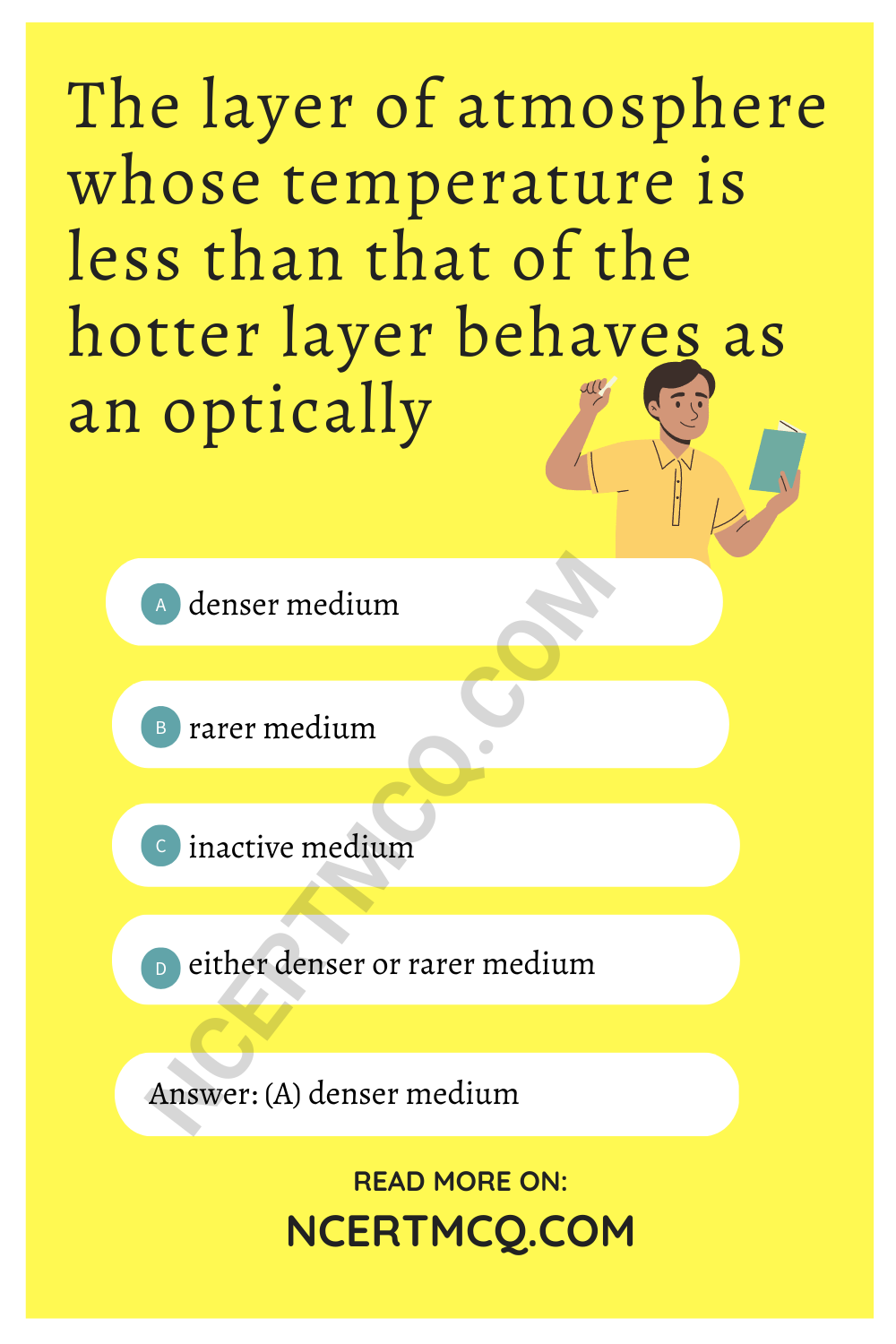
Explanation: The layer of atmosphere whose temperature is less than that of hotter layer is more denser as compared to the hotter layer of the atmosphere. So, when light travels from a cooler layer of atmosphere to a hotter Layer, it will bend away from the normal.
Question 24.
The sun appears white at noon as:
(a) Blue colour is scattered the most
(b) Red colour is scattered the most
(c) Light is least scattered
(d) All the colours of the white light are scattered away
Answer:
Assertion Reasoning questions Class 10 Science Chapter 11
For the following questions, two statements are given-one tabled Assertion (A) and the other labeled Reason (R) select the correct answer to these questions from the codes (a), (b), (c) and (d) as given below: ,
(a) Both (A) and (R) are true and (R) is correct explanation of the (A).
(b) Both (A) and (R) are true but (R) is not correct explanation of the (A).
(c) (A) is true but (R) is false.
(d) (A) is false but (R) is true.
Question 25.
Assertion (A): Sky appears in blue colour.
Reason (R): Blue colour in sunlight travelling through atmosphere undergoes maximum scattering.
Answer:
(a) Both (A) and (R) are true and (R) is the correct explanation of the (A).
Explanation: The blue colour of the sky is due to the scattering of blue colour to the maximum extent by dust particles. The blue colour appears to be coming from the sky. Blue colour has the least wavelength. Hence, the correct option is (a).
![]()
Question 26.
Assertion (A): When white light passes through a glass prism, red colour has deviated the least.
Reason (R): Red colour has the minimum speed in the glass prism.
Answer:
(c) (A) is true but (R) is false.
Explanation: When white light passes through a glass prism, red colour deviates the least because red colour has maximum speed in the prism.
Question 27.
Assertion (A): When objects are observed through hot air, they appear to be moving slightly.
Reason (R): Hotter air is optically denser and the cooler air is optically rarer.
Answer:
Question 28.
Assertion (A): A rainbow is always formed in the sky after a rain shower and in the same direction as the sun.
Reason (R): Water droplets act as tiny prisms.
Answer:
(d) (A) is false but (R) is true.
Explanation: A rainbow is always formed in the sky in a direction opposite to that of the sun. The water droplets present in the sky act as tiny prisms, which refract and disperse sunlight, then reflect it internally and finally refract it again when it comes out of the raindrop.
![]()
Question 29.
Assertion (A): The sun’s disc appears to be flattened at sunrise and sunset.
Reason (R): The sun is near the horizon at sunrise and sunset and sunlight suffers atmospheric refraction.
Answer:
(Competency Based Questions (CBQs))
Question 1.
Ankit remarked that he has seen wavering of objects when seen through a stream of hot air rising above a tandoor or a fire. He said that the air just above the fire becomes hotter than the air further higher up. He further said that this wavering can also be seen in the earth’s atmosphere as the earth’s atmosphere is not evenly distributed and several observations can be explained on the basis of this phenomenon.
(A) Name the phenomenon about which Ankit remarked.
(B) Name two observations which can be explained by the above phenomenon.
(C) What is the total time difference on duration of day on earth?
(D) Why don’t planets twinkle?
Answer:
(B) The two observations are: twinkling of stars, advance sunrise, delayed sunset and apparent position of stars. (Any two).
(D) Planets are much closer to the earth and can be considered as extended sources or a collection of several point sources. The total variation in intensity of light entering our eyes from each of these point sources average out to zero, thereby nullifying the twinkling effect.
Question 2.
Renu was returning home after purchasing some medicines for her mother. It was noon and really very hot on that particular day. She tried to look at the sun but the sun was shining so brightly that she could hardly see it directly. She somehow managed to see its reflection on a window and noticed that the colour of sun was white.
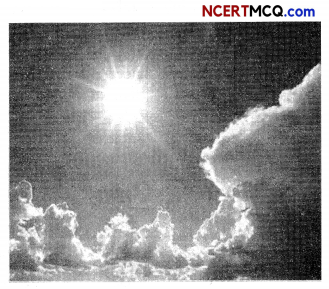
At noon, the Sun appears white as:
(a) light is least scattered
(b) all the colours of the white light are scattered away
(c) blue colour is scattered the most
(d) red colour is scattered the most
Answer:
(a) light is least scattered
Explanation: At noon, the sun is directly over head and has lesser air to travel through and thus will be reduced if the distance to be traveled in air is reduced. Less scattering leads to the Sun appearing white as only a little of the blue and violet colour is scattered.
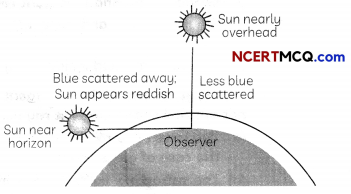
Question 3.
Raman is a keen observer and loved the spectacular colours in a rainbow. He also observed the same pattern when he allowed sunlight to pass through a glass prism. He guessed that it is due to the inclined refracting surfaces of a glass prism which is responsible for showing such exciting phenomenon. Whereas, no such phenomenon was observed when light passes through a glass slab.
(A) Name the phenomenon which could explain the formation of rainbow.
Answer:
The phenomenon which could explain the formation of rainbow is dispersion or splitting of light into its component colours.
(B) What is the band of colours known as?
Answer:
(C) What is the cause of formation of band of colours?
Answer:
The cause for formation of spectrum of light is that different colours of Light bend through different angles with respect to the incident ray as light passes through a prism,
(D) Why don’t we observe similar band of colours when light passes through a glass slab?
Answer:
We don’t observe splitting of white light into its component colours when light passes through a glass slab because the refracting surfaces in a glass slab are parallel to each other whereas they are inclined at an angle in a glass prism
![]()
Question 4.
Sunny and his friends went to the terrace of their apartment building to watch the night sky. They noticed that all apartment buildings had red light installed at the terrace. Sunny had also seen red lights on top of tall towers such as the Pitampura TV tower and even on top of the GSM towers.
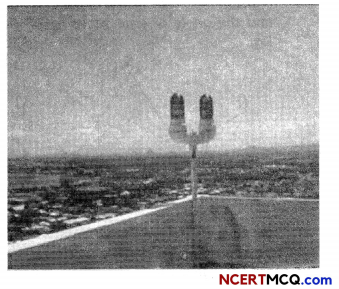
The danger signals installed at the top of tall buildings are red in colour, These can be easily seen from a distance because among all other colours, the red light:
(a) is scattered the most by smoke or fog
(b) is scattered the least by smoke or fog
(c) is absorbed the most by smoke or fog
(d) moves the fastest in air
Answer:
(b) is scattered the Least by smoke or fog
Explanation: Among all the colours, red is scattered the Least by smoke or fog. This is because the wavelength of red colour is the largest. Thus, it can be easily seen from a distance. Since the wavelength of red light is maximum in the spectrum, it’s penetration power in the air is maximum and so we can see red colour from farther distances, thus, danger signal uses red colour.
Question 5.
Fix a sheet of white paper on a drawing board using drawing pins. Place a glass prism on it in such a way that it rests on its triangular base. Trace the outline of the prism using a pencil. Draw a straight line PE inclined to one of the refracting surfaces, say AB, of the prism. Fix two pins, say at points P and Q, on the line PE as shown in Fig. below.
Look for the images of the pins, fixed at P and Q, through the other face AC. Fix two more pins, at points R and S, such that the pins at R. and S and the images of the pins at P and Q lie on the same straight line. Remove the pins and the glass prism. The line PE meets the boundary of the prism at point E. Similarly, join and produce the points R and S. Let these lines meet the boundary of the prism at E and F, respectively. Join E and F. Draw perpendiculars to the refracting surfaces AB and AC of the prism at points E and F, respectively. Mark the angle of incidence (i), the angle of refraction (r) and the angle of emergence (e) as shown in Fig.
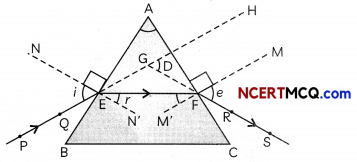
(A) Given below are four statements regarding incident ray, refracted ray and emergent ray in the above figure.
Select the incorrect statements:
(I) PE is the incident ray.
(II) EF is the emergent ray.
(III) EF is the refracted ray and FS is the emergent ray.
(IV)PE is the incident ray and FS is the refracted ray.
(a) Both (1) and (II)
(b) Both (I) and (III)
(c) Both (II) and (IV)
(d) Both (III) and (IV)
Answer:
(c) Both (II) and (IV)
Explanation: Here PE is the incident ray, EF is the refracted ray and FS is the emergent ray. PE is the incident ray as light, is incident on the prism face AB. Light undergoes refraction in the glass prism and bends away from the normal and hence EF is the refracted ray. The ray FS is the emergent ray as light emerges out of the face AC of the prism along this direction.
(B) The angles of incidence (i), refraction (r) and emergence (e) are mentioned in the table below. Select the row containing the correct marking of angles:
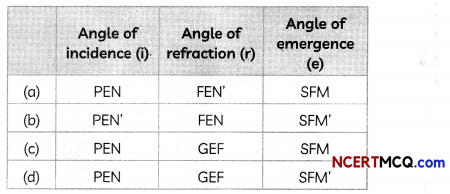
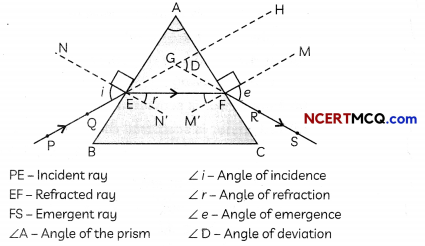
Answer:
(C) The angle of deviation is the angle between:
(a) Refracted ray and incident ray
(b) Refracted ray and emergent ray
(c) Emergent ray and face AC of the prism
(d) Emergent ray and incident ray
Answer:
(D) In a glass prism, the emergent ray is not parallel to the incident ray as:
(a) The laws of refraction do not hold in the case of glass prism.
(b) The refracting surfaces are inclined at an angle.
(c) The angle of refraction in glass is greater than the angle of incidence.
(d) The angle of refraction in glass is greater than the angle of emergence.
Answer:
(E) If n is the refractive index of glass of which the prism is made, which of the following relations is correct ?
(a) n = \(\frac{\sin \angle i}{\sin \angle r}\)
(b) n = \(\frac{\sin \angle r}{\sin \angle i}\)
(c) n = \(\frac{\sin 90^{\circ}}{\sin \angle e}\)
(d) n = \(\frac{\sin \angle r}{\sin \angle e}\)
Answer:
(a) n = \(\frac{\sin \angle i}{\sin \angle r}\)
Question 6.
While walking along the beach in Mumbai, Madhuri and her friends were amazed at the beauty of the setting sun and its reflection on the sea against the backdrop of buildings. They observed that the sun appeared reddish at sunset and even at sunrise.

Which of the following phenomena contributes significantly to the reddish appearance of the sun at sunrise or sunset?
(a) Dispersion of light
(b) Scattering of light
(c) Total internal reflection of light
(d) Reflection of light from Earth
Answer:
(b) Scattering of light
Explanation: Scattering of light contributes to the reddish appearance of the Sun at sunrise or sunset. Near the horizon, most of the blue light and shorter wavelengths are scattered away by the particles. Therefore, the light that reaches our eyes is of longer wavelengths. The red light has the maximum wavelength. This gives rise to the reddish appearance of the Sun.
Related Theory
Light from the Sun, near the horizon, passes through thicker layers of air and a large distance in Earth’s atmosphere before reaching our eyes. Near the horizon, most of the blue light and shorter wavelengths are scattered awau by the particles. Therefore, the light that reaches our eyes is of longer wavelengths. The red light has the maximum wavelength. This gives rise to the reddish appearance of the Sun.
![]()
Question 7.
Place a strong source (S) of white light at the focus of a converging lens (Lj). Allow the light beam to pass through a transparent glass tank (T) containing clear water. Allow the beam of light to pass through a circular hole (c) made in a cardboard. Obtain a sharp image of the circular hole on a screen (MN) using a second converging lens (Ly), as shown in Fig. below.
Dissolve about 200 g of sodium thiosulphate (hypo) in about 2 L of clean water taken in the tank. Add about 1 to 2 mi of concentrated sulphuric acid to the water.
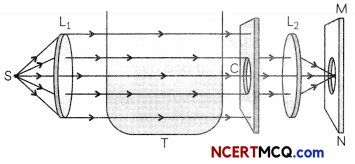
(A) What is the role of lenses L1 and L2 in the activity?
| Role of Lens L1 | Role of Lens L2 |
| (a) Converges a beam of light placed at S | Converges a parallel beam of light |
| (b) Provides a parallel beam of light | Converges a parallel beam of light |
| (c) Provides a parallel beam of light | Provides a parallel beam of light |
| (d) Converges a beam of light placed at S | Provides a parallel beam of light |
Answer:
(B) When about 200 g of sodium thiosulphate (hypo) is dissolved in about 2 L of clean water taken in the tank and about 1 to 2 mL of concentrated sulphuric acid is added to the water, it is observed that:
(a) A true solution is formed after 2 to 3 minutes.
(b) A suspension of sodium is formed in the tank
(c) Sulphur particles start precipitating in about 2 to 3 minutes.
(d) No change is observed.
Answer:
(c) Sulphur particles start precipitating in about 2 to 3 minutes.
Explanation: We will find fine microscopic sulphur particles precipitating in about 2 to 3 minutes due to the reaction between sulphuric acid and sodium thiosulphate.
(C) The observations regarding change in colour of light in the tank about 2 to 3 minutes after adding sulphuric acid to hypo is:
(I) Blue light can be seen from the side of the tank facing the circular hole.
(II) Blue light can be seen from the three sides of the glass tank.
(III) At first orange-red light and then red light can be seen from the side of the tank facing the circular hole.
(IV) At first orange-red light and then red light can be seen from the three sides of the glass tank.
Select the incorrect observations:
(a) Both (I) and (III)
(b) Both (II) and (III)
(c) Both (I) and (IV)
(d) Both (II) and (IV)
Answer:
(D) The observations can be explained by the phenomenon of:
(a) Scattering of light
(b) Reflection of light
(c) Refraction of light
(d) Dispersion of light
Answer:
(E) The activity above helps us in understanding:
(a) Twinkling of stars
(b) Formation of rainbow
(c) Advance sunrise and delayed sunset
(d) Reddish appearance of the Sun at the sunrise
Answer:
(d) Reddish appearance of the Sun at the sunrise
Explanation: This activity demonstrates the scattering of light that helps us to understand the bluish colour of the sky and the reddish appearance of the Sun at the sunrise or the sunset. Near the horizon, most of the blue light and shorter wavelengths are scattered away by the particles. Therefore, the light that reaches our eyes is of longer wavelengths. This gives rise to the reddish appearance of the Sun.
Question 8.
Parth noticed that his father had two sets of spectacles. So he asked him the reason for the same. His father explained that one spectacle is for viewing distant objects while the other is for reading books. It means that his father had both the defects of vision- farsightedness as well as nearsightedness.

The defect of vision in which the image of nearby objects is formed behind the retina is
(a) Near sightedness
(b) Cataract
(c) Far sightedness
(d) Presbyopia
Answer:
(c) Far sightedness
Explanation: Farsightedness or hypermetropia is the defect of vision in which the image of a nearby object is formed behind the retina due to either long focal length of the eye lens or shortening of the eye ball.
![]()
Question 9.
We’ve all seen that part in the movie where the weary desert wanderer has been walking for hours and is dying of thirst. Then he happens upon a vast body of water on the horizon. He runs towards the water, it grows closer and closer, until he springs himself into the air only to land back down in the sand and no water in sight. Well, that is due to an optical illusion called Mirage.
Mirage is an optical phenomenon which creates an illusion of the presence of water and is a result of refraction of light from a non-uniform medium. Mirage is observed mainly during sunny days when driving on a roadway. Normally, light waves from the sun travel straight through the atmosphere to your eye. But, light travels at different speeds through hot air and cold air.
Mirages happen when the ground is very hot and the air is cool and a ray of light gets refracted more and more away from the normal. At a particular angle when a ray of light exceeds critical angle, total internal reflection takes place and ray of light gets reflected in the same medium. When the reflected ray reaches our eye, it appears as coming from tree or sky and hence the inverted image of tree creates an impression from a pond of water.

(A) Mirage is an example of:
(a) Reflection of tight and Refraction of Light
(b) Dispersion of Light
(c) Total internat Reflection
(d) Refraction of Ught and Total internal Reflection of Light
Answer:
(d) Refraction of light and Total Internal Reflection of Light
Explanation: As the air just above the ground is hotter than the air above it, light traveling from a distant object travels from a denser medium to a rarer medium and hence bends away from the normal. So, it undergoes refraction. Since light is travelling from a denser medium to a rarer medium, at a certain angle which is greater than the critical angle, the light undergoes total internal reflection.
(B) Mirages are more common in:
(a) rainforests
(b) dry forests
(c) deserts
(d) highlands
Answer:
(c) deserts

Explanation: Mirages are formed on hot sunny days in deserts or road surfaces when the air just above the ground is much hotter than the air above it.
(C) Mirage is formed because:
(I) Air above the ground is very hot and air above is cooler
(II) Air above the ground is cooL and air above is warmer.
(III) Light rays from a distant object bend towards the normal when coming towards the ground.
(IV) Light rays from a distant object bend away from the normal when coming towards the ground.
(a) Both (I) and (III)
(b) Both (I) and (IV)
(c) Both (II) and (III)
(d) Both (II) and (IV)
Answer:
(b) Both (I) and (IV)
Explanation: Mirage is formed on a hot day when the air just above the ground is hotter than the air above it. As hotter air is optically rarer than cooler air, light traveling from a distant object travels from a denser medium to a rarer medium and hence bends away from the normal. Since light is travelling from a denser medium to a rarer medium, at a certain angle which is greater than the critical angle, the light undergoes total internal reflection.
(D) Atmospheric refraction occurs because:
(a) Refractive index in medium is gradually changing
(b) Of presence of dust particles in atmosphere
(c) Large amount of moisture is present in atmosphere on a humid day
(d) Sun’s rays travel the most when sun is near the horizon
Answer:
(E) When starlight enters the earth’s atmosphere:
(a) it bends away from the normal
(b) It bends towards the normal
(c) It first bends towards the normal and then away from the normal
(d) It first bends away from the normal and then towards the normal.
Answer:
![]()
Question 10.
The rising sun looks so beautiful! On a trip to a hill station, Raj was overjoyed to see such a beautiful sight of the sun just rising above the horizon! But his father later told him that the sun had not risen yet and what he is actually seeing is due to an optical phenomenon!
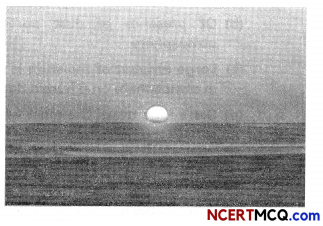
Why is the sun visible to us 2 minutes before actual sunrise and 2 minutes after actual sunset?
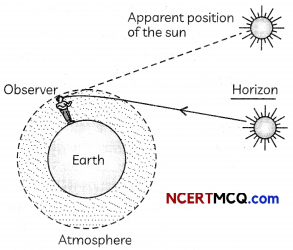
Answer:
The sun is visible to us 2 minutes before actual sunrise and 2 minutes after actual sunset due to the phenomenon of atmospheric refraction. During this time when the sun is still below the horizon, the sun’s rays enter the earth’s atmosphere and undergo continuous refraction and bend towards the normal as the refractive index increases continuously as we reach the earth’s surface. So. the sun is visible to us.
Question 11.
The inner workings of the human eye are corn ple but at the same time, fascinating. Have you wondered how exactly they do work or what are the major parts of the eye involved in creating Vision? It helps us in visualizing objects and also helps us in light perception, color, and depth perception. Besides, these sense organs are pretty much similar to cameras, and they help us see objects when light coming from outside enters into them. The structures and functions of the eyes are complex. Each eye constantly adjusts the amount of light it lets in, focuses on objects near and far, and produces continuous images that are instantly transmitted to the brain.
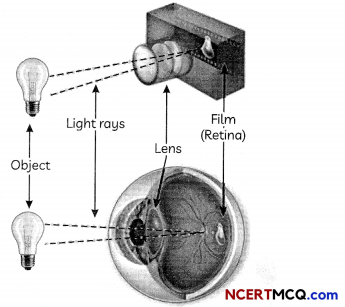
(A) The image formed by eye tens ¡s:
(a) Real and erect
(b) Virtual and erect
(c) Real and inverted
(d) Virtual and inverted
Answer:
(c) Real and inverted
Explanation: The eye Lens forms an inverted and real image of the object on the retina as eye tens is a convex lens.
(B) Most of the refraction for the light rays entering the eye occurs at:
(a) Outer surface of the cornea.
(b) Eye Lens
(c) Pupil
(d) Vitreous humour
Answer:
(a) Outer surface of the cornea.
Explanation: Most of the refraction for the Light rays entering the eye occurs at the Outer surface of the cornea. The crystalline Lens mereLy provides the finer adjustment of focal length required to focus objects at different distances on the retina.
(C) Select the correct statements:
(I) The change in the curvature of the eye lens can change its focal length.
(II) When the citiary muscles are relaxed, the Lens becomes thin and its focal length decreases.
(III) When the ciliary muscles contract, the Lens becomes thicker and its focal length increases.
(IV)Thin tens enables us to view distant objects clearly whereas thick lens enables us to see nearby objects clearly.
(a) Both (I) and (III)
(b) Both (I) and (IV)
(c) Both (II) and (III)
(d) Both (II) and (IV)
Answer:
(D) The near point and far point of a young adult with normal vision is:
(a) Near point = 0 cm and Far point = 25cm
(b) Near point = 25 cm and far point = 50 m
(c) Near point = 0 m and far point = infinity
(d) Near point = 25 cm and far point = infinity
Answer:
(E) Select the row containing incorrect part of human eye and its function
| Part of Human Eye | Function |
| (a) Retina | Delicate membrane having Large number of Light-sensitive cells. |
| (b) Iris | Changes the curvature of eye Lens |
| (c) Cornea | A thin membrane through which Light enters the eye |
| (d) Pupil | An aperture that regukites and controls the amount of Light |
Answer:
(b) Part of Human Eye: Iris; Function: Change the curvature of eye Lens.
Explanation: Iris is a dark muscular assembly that controls the size of the pupil. The muscle that changes the curvature of eye lens is ciliary muscles.
![]()
Question 12.
Shradhas parents took her grandfather to the eye speciaList as he was complaining of difficulty in seeing things. The doctor diagnosed it as cataract and said that it is quite common in old age.
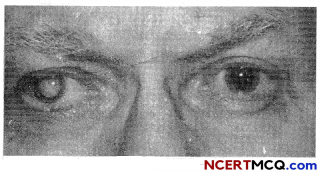
What is cataract? How is it caused? How can it be corrected?
Answer:
The condition when there is partial or complete loss of vision in the eye of people at old age is known as cataract. It is caused when the crystalline lens of eye becomes milky andcloudy.
It can be corrected through a cataract surgery.
Question 13.
Piyush, who was a backbencher in class, started complaining of frequent headaches. His parents took him to the nearest clinic and the doctor referred him to the eye specialist. The eye specialist tested his vision and asked Piyush whether he was able to read whatever the teacher wrote on the blackboard clearly or not. He replied in the negative. The doctor told his parents about the defect of vision that Piyush was suffering from and advised corrective glasses.
After wearing the glasses, Piyush was now able to read the black board clearly and also got rid of his headaches.
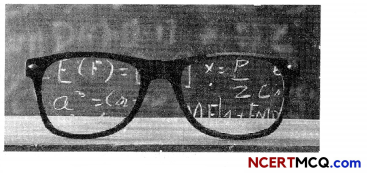
(A) @Piyush was suffering from:
(a) Cataract
(b) Myopia
(c) Hypermetropic
(d) Presbyopia
Answer:
(B) Select the correct statements regarding the defect of vision Piyush was suffering from:
(I) A person with this defect has the far point nearer than infinity.
(II) A person with this defect has the near point greater than the least distance of distinct vision.
(III) A person suffering from this defect may see clearly upto a distance of a few metres.
(IV) A person suffering from this defect may not see clearly beyond the near point.
(a) Both (I) and (III)
(b) Both (II) and (III)
(c) Both (I) and (IV)
(d) Both (II) and (IV)
Answer:
(a) Both (I) and (III)
Explanation: As Piyush is suffering from myopia, a person with this defect has the far point nearer than infinity. A person suffering from this defect may see clearly upto a distance of a few metres. That is why myopia is also known as short sightedness.
(C) Which of the following is not true about the defect of vision Piyush is suffering from ?
(a) It is caused due to excessive curvature of the eye lens
(b) It may be caused due to elongation of the eyeball.
(c) The image of a distant object is formed behind the retina.
(d) It is corrected by using a concave lens of appropriate power.
Answer:
(D) The far point of a myopic person is 50 cm in front of the eyes. The nature and power of the lens required for correct the problem is:
| Nature of Lens | Power of Lens |
| (a) Concave | – 0.5 D |
| (b) Concave | – 2.0 D |
| (c) Convex | + 0.5D |
| (d) Convex | + 2.0D |
Answer:
(b) Nature of Lens – Concave: Power of Lens – 2.0 D
Explanation: To find the focal length, we use the lens formula
\(\frac{1}{f}=\frac{1}{v}-\frac{1}{u} \Rightarrow \frac{1}{f}=-\frac{1}{50}\) ⇒ f = – 0.5 m
Power of the lens = \(-\frac{1}{0.5}\) = – 2.0 D
As focal length of the corrective lens is negative, the type of lens used is a concave lens.
(E) A person needs a lens of power – 4.5 D for correction of her vision. The nature of lens and its focal length is:
| Nature of Lens | Focal length |
| (a) Concave | – 45cm |
| (b) Convex | – 45cm |
| (c) Convex | + 22.22 cm |
| (d) Concave | + 22.22 cm |
Answer:
(d) Nature of Lens – Concave :Focal Length – 22.22 cm
Explanation: It is given that the power of the corrective lens = – 4.5 D. We know that
As the focal length is negative, the lens is a concave lens.
![]()
Question 14.
Pankaj noticed that while reading books or newspaper, most people keep the book neither too far nor too close to their eyes. So, he himseLf tried to find out what happens when he tried to read the book by keeping the book quite far. He immediately said that he could not read all Letters clearly. When he tried to read a book by keeping it very dose to his eyes, the letters had become blurred and his eyes started paining!
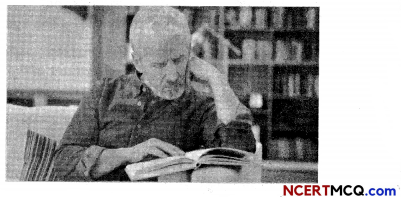
Why is a normal eye not able to see clearly the objects placed closer than 25 cm?
Answer:
The normal eye has the remarkable property to see objects when placed at any distance from the eye due to the ability of the eye lens to adjust its focal length which is called accommodation. However, the normal eye is not able to see clearly objects placed closer to 25 cmas the focal length of the eye lens cannot bedecreased below a certain minimum limit.
Question 15.
Everyone enjoys the spectacle of a rainbow glimmering against a dark stormy sky. How does sunlight falling on clear drops of rain get broken into the rainbow of colors we see? The same process causes white light to be broken into colors by a clear glass prism or a diamond. Sunlight, considered to be white, actually appears to be a bit yellow because of its mixture of wavelengths, but it does contain all visible wavelengths.
The sequence of colors in rainbows is the same sequence as the colors plotted versus wavelength in Figure below. What this implies is that white light is spread out according to wavelength in a rainbow.
(A) The phenomena that play a role in the formation of rainbow is:
(a) Reflection and refraction of light
(b) Refraction, absorption, dispersion and refraction of light
(c) Dispersion, refraction and reflection of light
(d) Refraction, dispersion, reflection and refraction of light
Answer:
(d) Refraction, dispersion, reflection and refraction of light
Explanation: Rainbow is produced after the rain, by refraction, dispersion, total internal reflection and again refraction process in droplets of water
(B) Select the colours in the correct ascending of wavelength:
(a) Blue, Green, Red
(b) Orange, Green, Red
(c) Blue, Yellow, Green
(d) Orange, Yellow, Green
Answer:
(C) Select the incorrect statements about rainbow:
(I) Rainbow is caused by scattering of sunlight by tiny water droplets, present in the atmosphere.
(II) A rainbow is always formed in a direction opposite to that of the Sun.
(III) The water droplets refract and scatter the incident sunlight, then reflect it internally, and finally refract it again when it comes out of the raindrop.
(IV) Different colours reach the observer’s eye due to the scattering of light and internal reflection.
(a) Both (I) and (II)
(b) Both (II) and (III)
(c) (I), (III) and (IV)
(d) (II), (III) and (IV)
Answer:
(c) (I), (III) and (IV)
Explanation: A rainbow is a natural spectrum appearing in the sky after a rain shower, it is caused by dispersion of sunlight by tiny water droplets, present in the atmosphere which act like small prisms. A rainbow is always formed in a direction opposite to that of the Sun. The tiny droplets of water refract and disperse the incident sunlight, then reflect it internally, and finally refract the light again when it comes out of the raindrop. Due to the dispersion of light and internal reflection, different colours reach the observer’s eye.
(D) A spectrum of light is observed when white light is directed to a prism as:
(a) The different colours in the white light bend away from the normal line at different angles on entering prism.
(b) The different colours in the white
light bend towards the normal line at different angles on entering prism.
(c) The different colours in the white light bend away from the normal at same speed to each other on entering prism.
(d) The different colours in the white light bend towards the normal at same speed to each other on entering prism.
Answer:
(E) The velocity of waves of all colours is same in:
(a) Water
(b) Oxygen
(c) Vacuum
(d) Glass
Answer:
![]()
Question 16.
Mike and his friends were enjoying a bonfire in their garden. One of his friends noticed that the air above the fire was wavering. He realized that this is because the physical conditions of air are notstationary because of which the apparent position of the object, as seen through the hotair, changes continuously. This phenomenon can also be used to explain several observations around us.

Why do stars appear higher than they actually are?
Answer:
Stars appear higher than they actually are due to the phenomenon of atmospheric refraction. When the starlight enters the earth’s atmosphere, it undergoes refraction continuously before it reaches the earth as the refractive index of the atmosphere changes continuously. The atmosphere bendsstarlight towards the normal due to which the apparent position of thestar is slightly different from its actual position.
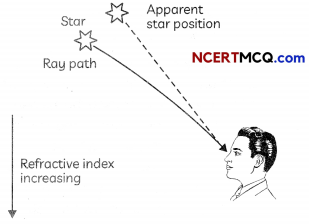
Question 17.
In addition to being absorbed or transmitted, electromagnetic radiation can also be reflected or scattered by particles in the atmosphere. Scattering is the redirection of electromagnetic energy by suspended particles in the atmosphere. The Tyndall effect is light scattering by particles in a colloid or in a very fine suspension.
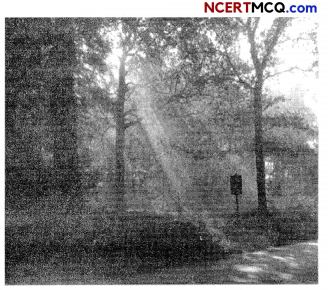
The type and amount of scattering that occurs depends on the size of the particles and the wavelength of the energy. Rayleigh scatter occurs when radiation (light) interacts with molecules and particles in the atmosphere that are smaller in diameter than the wavelength of the incoming radiation. Shorter wavelengths are more readily scattered tha longer wavelengths.

(A) Which of the following will not show Tyndall effect?
(a) Milk
(b) Sugar solution
(c) Smoke
(d) Emulsion
Answer:
(b) Sugar solution
Explanation: Tyndall effect is shown by colloids and suspensions but not shown by true solutions. As sugar solution is a true solution, it will not show Tyndall effect.
(B) Tyndall effect is due to
(a) Refraction of light
(b) Dispersion of light
(c) Absorption of light
(d) Scattering of light
Answer:
(d) Scattering of light
Explanation: Tyndall effect is due to scattering of light by particles present in the atmosphere, such as smoke, fine dust particles and gas molecules.
(C) Which of the following natural phenomena are not due to scattering of light in nature?
(I) Blue colour of sky
(II) Twinkling of stars
(III) Formation of rainbow
(IV) Colour of water in deep sea
(a) Both (I) and (II)
(b) Both (II) and (III)
(c) Both (II) and (IV)
(d) Both (III) and (IV)
Answer:
(D) The table below lists the colour of scattered light for different sizes of scattering particles.
Select the row containing the correct information:
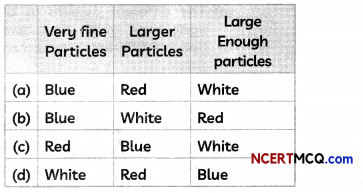
Answer:
(E) The blue colour of the sky is because:
(a) Red colour is scattered more as compared to other colours
(b) Red colour is absorbed more as compared to other colours
(c) Blue colour is scattered more as compared to other colours
(d) Blue colour is absorbed more as compared to other colours
Answer:
(c) Blue colour is scattered more as compared to other colours
Explanation: The molecules of air and other fine particles in the atmosphere have sizesmaller than the wavelength of visible light and these are more effective inscattering Light of shorter wavelengths at the blue end than light of longerwa wavelengths at the red end. Thus, when sunlight passes through the atmosphere, the fine particles in air scatter the blue colour (shorter wavelengths) more strongly than red and the sky appears blue to us as the scattered blue light entersour eyes.
Very Short Answer Type Questions
Question 1.
What would have been the colour of sky if the earth had no atmosphere?
Answer:
![]()
Question 2.
Why do stars appear higher than their actual position?
Answer:
Stars appear higher than their actual position as starlight undergoes refraction continuously on entering earth’s atmosphere and bends towards the normal.
Question 3.
On the basis of which observation did Newton conclude that sunlight is made up of seven colours?
Answer:
Question 4.
How does the refractive index of earth’s atmosphere vary with height?
Answer:
Question 5.
Why is a small amount of sodium thiosulphate added to water in tank in the activity to understand reddish appearance of sun at sunrise and sunset?
Answer:
Sodium thiosulphate is added to water in the tank for precipitating minute colloidal sulphur particles which scatter short wavelengths of Light.
Question 6.
State one effect produced by the scattering of light by the atmosphere?
Answer:
There are two effects produced due to scattering of light in the atmosphere: Tyndall effect and appearance of the blue colour of the sky.
Related Theory
When light moves from one medium to another, the light scatters in different directions due to change in the medium. This is called scattering of light. When tiny particles of dust come in front of light and leads to its scattering, this is called Tyndall effect. We can see these tiny dust particles in the scattered light.
When the light from stars enters the atmosphere, the light with smaller wavelengths gets easily scattered, while lights with longer wavelength do not scatter much and hence travels straight. This gives red colour to the sky during sunrise and sunset.
On the other hand, the shorter wavelengths scatter in the sky and give the sky its usual blue colour.
Question 7.
An astronaut in space finds sky to be dark. Explain reason for this observation. [Diksha]
Answer:
![]()
Question 8.
What is a rainbow? Draw a labelled diagram to show the formation of a rainbow.
Answer:
Rainbow: A rainbow is a natural spectrum formed in the sky after a rain shower due to the dispersion of sunlight by the tiny droplets of water present in the atmosphere. The tiny droplets of water act like small prisms which refract and disperse the incident sunlight, then reflect the light internally and finally refract it again when it comes out of the raindrop. Different colours reach the observer’s eyes due to the dispersion of light and internal reflection.
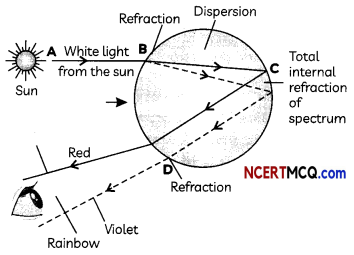
Question 9.
Why does the sun appear white at noon?
Answer:
MCQ Questions for Class 10 Science with Answers
Class 10 Science Physics MCQ:

